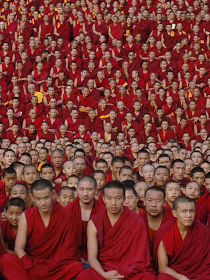- Home
- FPMT Homepage
Foundation for the Preservation of the Mahayana Tradition
The FPMT is an organization devoted to preserving and spreading Mahayana Buddhism worldwide by creating opportunities to listen, reflect, meditate, practice and actualize the unmistaken teachings of the Buddha and based on that experience spreading the Dharma to sentient beings. We provide integrated education through which people’s minds and hearts can be transformed into their highest potential for the benefit of others, inspired by an attitude of universal responsibility and service. We are committed to creating harmonious environments and helping all beings develop their full potential of infinite wisdom and compassion. Our organization is based on the Buddhist tradition of Lama Tsongkhapa of Tibet as taught to us by our founders Lama Thubten Yeshe and Lama Thubten Zopa Rinpoche.
- Willkommen
Die Stiftung zur Erhaltung der Mahayana Tradition (FPMT) ist eine Organisation, die sich weltweit für die Erhaltung und Verbreitung des Mahayana-Buddhismus einsetzt, indem sie Möglichkeiten schafft, den makellosen Lehren des Buddha zuzuhören, über sie zur reflektieren und zu meditieren und auf der Grundlage dieser Erfahrung das Dharma unter den Lebewesen zu verbreiten.
Wir bieten integrierte Schulungswege an, durch denen der Geist und das Herz der Menschen in ihr höchstes Potential verwandelt werden zum Wohl der anderen – inspiriert durch eine Haltung der universellen Verantwortung und dem Wunsch zu dienen. Wir haben uns verpflichtet, harmonische Umgebungen zu schaffen und allen Wesen zu helfen, ihr volles Potenzial unendlicher Weisheit und grenzenlosen Mitgefühls zu verwirklichen.
Unsere Organisation basiert auf der buddhistischen Tradition von Lama Tsongkhapa von Tibet, so wie sie uns von unseren Gründern Lama Thubten Yeshe und Lama Thubten Zopa Rinpoche gelehrt wird.
- Bienvenidos
La Fundación para la preservación de la tradición Mahayana (FPMT) es una organización que se dedica a preservar y difundir el budismo Mahayana en todo el mundo, creando oportunidades para escuchar, reflexionar, meditar, practicar y actualizar las enseñanzas inconfundibles de Buda y en base a esa experiencia difundir el Dharma a los seres.
Proporcionamos una educación integrada a través de la cual las mentes y los corazones de las personas se pueden transformar en su mayor potencial para el beneficio de los demás, inspirados por una actitud de responsabilidad y servicio universales. Estamos comprometidos a crear ambientes armoniosos y ayudar a todos los seres a desarrollar todo su potencial de infinita sabiduría y compasión.
Nuestra organización se basa en la tradición budista de Lama Tsongkhapa del Tíbet como nos lo enseñaron nuestros fundadores Lama Thubten Yeshe y Lama Zopa Rinpoche.
A continuación puede ver una lista de los centros y sus páginas web en su lengua preferida.
- Bienvenue
L’organisation de la FPMT a pour vocation la préservation et la diffusion du bouddhisme du mahayana dans le monde entier. Elle offre l’opportunité d’écouter, de réfléchir, de méditer, de pratiquer et de réaliser les enseignements excellents du Bouddha, pour ensuite transmettre le Dharma à tous les êtres. Nous proposons une formation intégrée grâce à laquelle le cœur et l’esprit de chacun peuvent accomplir leur potentiel le plus élevé pour le bien d’autrui, inspirés par le sens du service et une responsabilité universelle. Nous nous engageons à créer un environnement harmonieux et à aider tous les êtres à épanouir leur potentiel illimité de compassion et de sagesse. Notre organisation s’appuie sur la tradition guéloukpa de Lama Tsongkhapa du Tibet, telle qu’elle a été enseignée par nos fondateurs Lama Thoubtèn Yéshé et Lama Zopa Rinpoché.
Visitez le site de notre Editions Mahayana pour les traductions, conseils et nouvelles du Bureau international en français.
Voici une liste de centres et de leurs sites dans votre langue préférée
- Benvenuto
L’FPMT è un organizzazione il cui scopo è preservare e diffondere il Buddhismo Mahayana nel mondo, creando occasioni di ascolto, riflessione, meditazione e pratica dei perfetti insegnamenti del Buddha, al fine di attualizzare e diffondere il Dharma fra tutti gli esseri senzienti.
Offriamo un’educazione integrata, che può trasformare la mente e i cuori delle persone nel loro massimo potenziale, per il beneficio di tutti gli esseri, ispirati da un’attitudine di responsabilità universale e di servizio.
Il nostro obiettivo è quello di creare contesti armoniosi e aiutare tutti gli esseri a sviluppare in modo completo le proprie potenzialità di infinita saggezza e compassione.
La nostra organizzazione si basa sulla tradizione buddhista di Lama Tsongkhapa del Tibet, così come ci è stata insegnata dai nostri fondatori Lama Thubten Yeshe e Lama Zopa Rinpoche.
Di seguito potete trovare un elenco dei centri e dei loro siti nella lingua da voi prescelta.
- 欢迎 / 歡迎
简体中文
“护持大乘法脉基金会”( 英文简称:FPMT。全名:Foundation for the Preservation of the Mahayana Tradition) 是一个致力于护持和弘扬大乘佛法的国际佛教组织。我们提供听闻,思维,禅修,修行和实证佛陀无误教法的机会,以便让一切众生都能够享受佛法的指引和滋润。
我们全力创造和谐融洽的环境, 为人们提供解行并重的完整佛法教育,以便启发内在的环宇悲心及责任心,并开发内心所蕴藏的巨大潜能 — 无限的智慧与悲心 — 以便利益和服务一切有情。
FPMT的创办人是图腾耶喜喇嘛和喇嘛梭巴仁波切。我们所修习的是由两位上师所教导的,西藏喀巴大师的佛法传承。
繁體中文
護持大乘法脈基金會”( 英文簡稱:FPMT。全名:Found
ation for the Preservation of the Mahayana Tradition ) 是一個致力於護持和弘揚大乘佛法的國際佛教組織。我們提供聽聞, 思維,禪修,修行和實證佛陀無誤教法的機會,以便讓一切眾生都能 夠享受佛法的指引和滋潤。 我們全力創造和諧融洽的環境,
為人們提供解行並重的完整佛法教育,以便啟發內在的環宇悲心及責 任心,並開發內心所蘊藏的巨大潛能 — 無限的智慧與悲心 – – 以便利益和服務一切有情。 FPMT的創辦人是圖騰耶喜喇嘛和喇嘛梭巴仁波切。
我們所修習的是由兩位上師所教導的,西藏喀巴大師的佛法傳承。 察看道场信息:
- FPMT Homepage
- News/Media
-
- Study & Practice
-
-
- About FPMT Education Services
- Latest News
- Programs
- New to Buddhism?
- Buddhist Mind Science: Activating Your Potential
- Heart Advice for Death and Dying
- Discovering Buddhism
- Living in the Path
- Exploring Buddhism
- FPMT Basic Program
- FPMT Masters Program
- FPMT In-Depth Meditation Training
- Maitripa College
- Lotsawa Rinchen Zangpo Translator Program
- Universal Education for Compassion & Wisdom
- Online Learning Center
-
- Prayers & Practice Materials
- Overview of Prayers & Practices
- Full Catalogue of Prayers & Practice Materials
- Explore Popular Topics
- Benefiting Animals
- Chenrezig Resources
- Death & Dying Resources
- Lama Chopa (Guru Puja)
- Lama Zopa Rinpoche: Compendium of Precious Instructions
- Lama Zopa Rinpoche: Life Practice Advice
- Lama Zopa Rinpoche Practice Series
- Lamrim Resources
- Mantras
- Prayer Book Updates
- Purification Practices
- Sutras
- Thought Transformation (Lojong)
- Audio Materials
- Dharma Dates - Tibetan Calendar
- Translation Services
- Publishing Services
- Ways to Offer Support
- Prayers & Practice Materials
-
- Teachings and Advice
- Find Teachings and Advice
- Lama Zopa Rinpoche Advice Page
- Lama Zopa Rinpoche: Compendium of Precious Instructions
- Lama Zopa Rinpoche Video Teachings
- ༧སྐྱབས་རྗེ་བཟོད་པ་རིན་པོ་ཆེ་མཆོག་ནས་སྩལ་བའི་བཀའ་སློབ་བརྙན་འཕྲིན།
- Podcasts
- Lama Yeshe Wisdom Archive
- Buddhism FAQ
- Dharma for Young People
- Resources on Holy Objects
- Teachings and Advice
-
-
*If a menu item has a submenu clicking once will expand the menu clicking twice will open the page.
-
-
- Centers
-
- Teachers
-
- Projects
-
-
-
-
*If a menu item has a submenu clicking once will expand the menu clicking twice will open the page.
-
-
- FPMT
-
-
-
-
-
Death could come any minute so transform your life into Dharma.
Lama Zopa Rinpoche
-
-
-
- Shop
-
-
-
The Foundation Store is FPMT’s online shop and features a vast selection of Buddhist study and practice materials written or recommended by our lineage gurus. These items include homestudy programs, prayers and practices in PDF or eBook format, materials for children, and other resources to support practitioners.
Items displayed in the shop are made available for Dharma practice and educational purposes, and never for the purpose of profiting from their sale. Please read FPMT Foundation Store Policy Regarding Dharma Items for more information.
-
-
Lama Zopa Rinpoche News and Advice
12
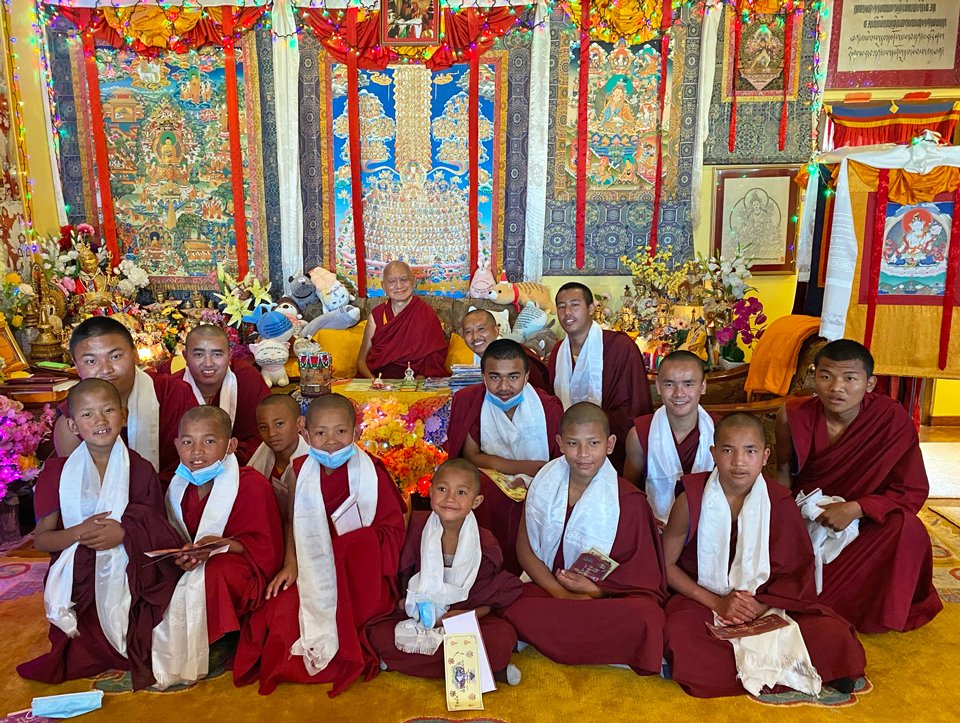
Lama Zopa Rinpoche with some young monks, Kopan Monastery, Nepal, March 2021. Photo by Ven. Roger Kunsang.
In the following excerpt from Lama Zopa Rinpoche’s video teachings on thought transformation, Rinpoche explains—in his animated “Lawudo comedian” style—the incredible merits that are collected by someone who teaches even one verse of Dharma to one sentient being.
As a sutra says, they collect more merits than someone who fills up as many buddha worlds as the number of sand grains of the River Ganga with the seven types of jewels and, with an extremely happy mind, offers them to the buddhas. Likewise, they collect more merit than someone who fills up the great-thousand-fold universes with gold and offers them to the buddhas.
Can you imagine the merits of someone who constantly travels the world teaching Dharma? You have to realize how your perfect human rebirth is so incredible!
Watch the ten-minute video “Your Perfect Human Rebirth Is Incredible Because You Can Use It to Teach Dharma“:
https://youtu.be/8HdweUyC_H0
Here is the transcript of Rinpoche’s teaching in this short video:
By Giving One Verse of Teachings to a Sentient Being, You Collect More Merits Than Offering a Great-Thousand-Fold Universes Filled with the Seven Types of Jewels
Today I want to mention one [quotation] to realize the human rebirth, the perfect human rebirth you have received now, how this is so wonderful. The unbelievable benefits you have, you have to recognize. [Therefore, I will give you some] more examples.
If you give teachings, if you give teachings to a sentient being, you have to understand the unbelievable, unbelievable merit you collect. This is from Sutra of the Roaring Sound of the Loving Kindness Lion, Sutra of Loving Kindness [Lion] Roaring Sound.[1] I think that might be the quotation where it is mentioned. First I will read the Tibetan.
གང་གིས་གངྒའི་བྱེ་སྙེད་སངས་རྒྱས་ཞིང་། །
རིན་ཆེན་བདུན་གྱིས་ཡོང་སུ་བཀང་བྱེད་ན། །
རབ་དགའ་སེམས་ཀྱིས་རྒྱལ་ལ་ཕུལ་བ་དང་། །
གང་གིས་སེམས་ཅན་གཅིག་ལ་ཚིགས་བཅད་བྱིན། །
Gang gi gang gäi je nye sang gyä zhing
Rin chhen dün gyi yong su kang je na
Rab ga sem kyi gyäl la phül wa dang
Gang gi sem chän chig la tshig chä jin
If someone fills up as many buddha worlds as the number
Of sand grains of the River Ganga with the seven types of jewels
And, with an extremely happy mind, offers them to the buddhas,
And if someone else gives one verse of teaching to one sentient being,
རིན་ཆེན་སྦྱིན་པ་ཤིན་ཏུ་རྒྱ་ཆེན་དེས། །
ཚིགས་བཅད་སྦྱིན་པ་སྙིང་རྗེས་བསྒྲུབས་དེ་ལ། །
ཆར་ཡང་མི་ཕོད་གྲངས་སུའང་མ་ཡིན་ནོ། །
Rin chhen jin pa shin tu gya chhen de
Tshig chä jin pa nying je drub de la
Chhar yang mi phö drang su’ang ma yin no
That extremely extensive jewel charity
Cannot be compared to giving one verse of teaching
With compassion, not even in number.
Oh, that. Now you understood. (Everyone laughs.) I don’t have to say anything. I will keep quiet. Hee-hee. Okay.
Gang gi gang gäi je nye sang gyä zhing, “Anybody,” Gang gi gang gäi je nye sang gyä zhing. Gang gäi gang gäi is the River Ganga, “according to the number of the River Ganga sand grains, that many buddha fields,” “buddhas’ worlds.” This world is called mi je jig ten zhing.[2] I think it is said it is the buddha field of Shakyamuni Buddha, I think. Something like that. Then, “completely filled up with the seven types of jewels,” diamonds, gold, and so forth, “completely filled up with the seven types of jewels,” full, then, “with an extremely happy mind you offer them to the buddhas.”
Then, “Anybody giving one verse of teaching,” one verse like this, “to one sentient being.” “Giving a verse of teaching with compassion,” “giving a verse,” “practice with compassion,” so that means, I think giving one verse of teaching with compassion. Chhar yang mi phö, “no comparison with the extremely extensive charity of jewels.”
[This is] what was mentioned before—the whole world filled with the seven types of jewels, completely full, and you offer them to the buddhas; so that becomes very small. With compassion giving one verse of teachings to a sentient being, it cannot compare to that extremely extensive jewel charity—no way. This is faaaaaaaar more greater benefits, Chhar yang mi phö drang su’ang ma yin no. Drang su’ang ma yin no means even by number, no way! It kind of becomes like that, it becomes numberless. Giving one verse of teaching with compassion to a sentient being, bah, bah, bah, far, bah, bah, bah, has far more greater merits, bah, bah, bah, than that much universes filled with jewels and offering them to the buddhas. Can you imagine it? Not only extensive offerings but you offer them to the buddhas; not bodhisattvas, not arhats, buddhas! So that, giving one verse of teaching with compassion, is faaaaaaaaaaaaaaaar more greater than, far, far, far, far more greater than that.By Giving One Verse of Teachings to a Sentient Being, You Collect More Merits Than Offering a Great-Thousand-Fold Universes Filled with Gold
There is another [quotation] from the same sutra, I think. [Sutra of the Roaring Sound of the Loving Kindness Lion says:]
[སྟོང་ཆེན་འཇིག་རྟེན་ཁམས་ནི་གསེར་དག་གིས། །
བཀང་སྟེ་གང་ལ་སྦྱིན་པར་བྱེད་པ་ནི། །
ཚིག་བཞིའི་ཚིགས་སུ་བཅད་པ་གཅིག་བརྗོད་པས། །
ཇི་ལྟར་ཕན་འདོགས་དེ་ལྟར་འགྱུར་མ་ཡིན། །
Tong chhen jig ten kham ni ser dag gi
Kang te gang la jin par je pa ni
Tshig zhii tshig su chä pa chig jö pä
Ji tar phän dog de tar gyur ma yin
Filling up the great-thousand-fold universes
With gold and offering them [to the buddhas]
Cannot be compared to the benefits of
Expressing one verse of four lines [to one sentient being].]
Universes, one, two, three, four up to a thousand; then another thousand, one, two, three, four up to a thousand is the second thousand; then like that thousand, one, two, three, four up to a thousand, that is the great-thousand of three-thousand-[fold] universes.[3] Like that, even like that, “many completely filled up with gold, completely full, then you offer to the buddhas.” Then, giving one verse of teaching to one sentient being is faaaaaaaar more greater, the benefits. Bah, bah, bah. Then there is the example that I mentioned just now.
You Have to Realize How Your Perfect Human Rebirth is Incredible Because You Create So Many Merits by Teaching Dharma!
Then, if you give teachings to two sentient beings—wow—double. The merits are, wow, wow, wow, double, you get. Then to three sentient beings, oh, triple! Wow, wow, wow. Therefore, if there are ten or fifteen [people], if there are sixty or seventy or one hundred or two hundred [people], bah, bah, bah, can you imagine, wow, wow, wow, wow, wow, wow, the benefits that you get, you who are teaching Dharma? Bah, bah, bah. Lama khyen, lama khyen, lama khyen. You have to understand.
Then those who are always busy giving teachings around the world, monks, nuns, and lay [people] who are traveling around—I don’t know, before there were quite a few but now I don’t know—yes, who are very busy running around, going around the world to give teachings, you have to understand. You have to realize that! Recognize that! You understand? It is like that. Bah, bah, bah. So then, to realize how your perfect human rebirth is incredible!
(Referring to the fact that he has been shouting) I’m the comedian. I’m Himalayan comedian. I’m the Lawudo comedian, the Himalayan mountain comedian.
Ven. Tsenla: Comedian.
Rinpoche: Huh?
Ven. Tsenla: Comedian.
Rinpoche: Comedian. Ha-ha. So as long as I don’t get you upset, then it’s okay. You may think I’m very funny, very strange, but that’s okay as long as you don’t get angry, angry, waaaw, and then eat me up, chomp, chomp, like a dog eats kaka.
Footnotes:
[1] འཕགས་པ་བྱམས་པའི་སེང་གེའི་སྒྲ་ཆེན་པོའི་མདོ།
[2] མི་མཇེད་འཇིག་རྟེན་ཞིང་ Unbearable World.
[3] The great-thousand of three-thousand-fold universes is 1000x1000x1000, that is, a billion universes.
The above video is extracted from Video 40: “This Perfect Human Body is So Precious Because You Can Use It to Do Prostrations.”
Watch more from the video series Lama Zopa Rinpoche’s Teachings on Thought Transformation during the Time of COVID-19, where you can also find links to transcripts, MP3s, additional practice advice, and more.
Read a summary of Rinpoche’s thought transformation teachings given in 2020 in the Mandala 2021 article “The Time to Practice Is Now: Lama Zopa Rinpoche’s Thought Transformation Teachings During the Time of COVID-19.”
Lama Zopa Rinpoche is the spiritual director of the Foundation for the Preservation of Mahayana Tradition (FPMT), a Tibetan Buddhist organization dedicated to the transmission of the Mahayana Buddhist tradition and values worldwide through teaching, meditation and community service.
- Tagged: advice from lama zopa rinpoche, essential extract, essential extract thought transformation teachings, perfect human rebirth, video
8

Lama Zopa Rinpoche giving an online teaching in his room at Kopan Monastery, Nepal, March 2021. Photo by Ven. Lobsang Sherab.
Lama Zopa Rinpoche continues his video teachings on thought transformation from Kopan Monastery in Nepal. Here is a summary of the most recent teaching:
Lama Zopa Rinpoche begins this teaching offering us a motivation for listening to the oral transmission of Sutra of Great Liberation. To have a good motivation one should think that one must free numberless sentient beings from oceans of samsaric suffering and bring them to enlightenment, the total cessation of suffering and the completion of realizations. Rinpoche then says one should think, “Therefore, I must achieve enlightenment. Therefore, I am going to listen to the teaching and receive the lung of this sutra.”
The reality is, we could die at any time, even before this session is finished. By this time next week, we could be dead. Anything can happen. Since you were born, many friends, family—even gurus—have passed away. We ourselves are in this process too. It could happen anytime.
It is not enough to just be mindful that we are going to die. You have to practice holy Dharma! Don’t just make yourself depressed thinking you are going to die. Use your awareness of death and impermanence to not be reborn in the lower realms, to be free from samsara, to be free from lower nirvana, and to generate bodhichitta—the best Dharma practice. Don’t make yourself more depressed by squeezing your mind, thinking, “Oh no, I’m going to die!” There is already so much depression in the world.
You are receiving the oral transmission for every single human being, sura and asura being, and intermediate state being in numberless universes. You are listening for everyone, for the benefit of everyone to achieve enlightenment and to free them from samsara first. This is not just something easy and relaxed to do, no! That is the motivation! This sutra is exactly what is needed in the world.
Rinpoche continues the oral transmission of Sutra of Great Liberation at 20:47 of this video.
We invite you to go deeper into the topics presented here, plus many others, by watching Rinpoche’s video and reading the full transcript of Rinpoche’s teaching.
Watch Lama Zopa Rinpoche’s teaching “Don’t Just Squeeze Your Mind Thinking ‘I’m Going to Die'”:
https://youtu.be/VC1ONf59R74
- Read the transcript of Rinpoche’s teaching
- Find videos with Rinpoche giving the oral transmission of the Sutra of Great Liberatation
- Find Rinpoche’s Teachings on Thought Transformation translated into Spanish, Italian, French, Chinese, and Russian
- Dedication verses for COVID-19 Crisis Teachings
Watch more from the video series Lama Zopa Rinpoche’s Teachings on Thought Transformation during the Time of COVID-19 and find links to videos in transcripts, MP3s, additional practice advice, and more:
https://fpmt.org/fpmt/announcements/resources-for-coronavirus-pandemic/advice-from-lama-zopa-rinpoche-for-coronavirus/
Practice advice from our teachers, Dharma study-from-home opportunities, and more can be found on the page “Resources for the Coronavirus Pandemic.”
Lama Zopa Rinpoche is the spiritual director of the Foundation for the Preservation of Mahayana Tradition (FPMT), a Tibetan Buddhist organization dedicated to the transmission of the Mahayana Buddhist tradition and values worldwide through teaching, meditation and community service.
- Tagged: advice from lama zopa rinpoche, coronavirus, impermanence and death, lama zopa rinpoche thought transformation video teaching, oral transmission, sutra of great liberation, video
6
Some Ways in Which Rinpoche Is Benefiting People
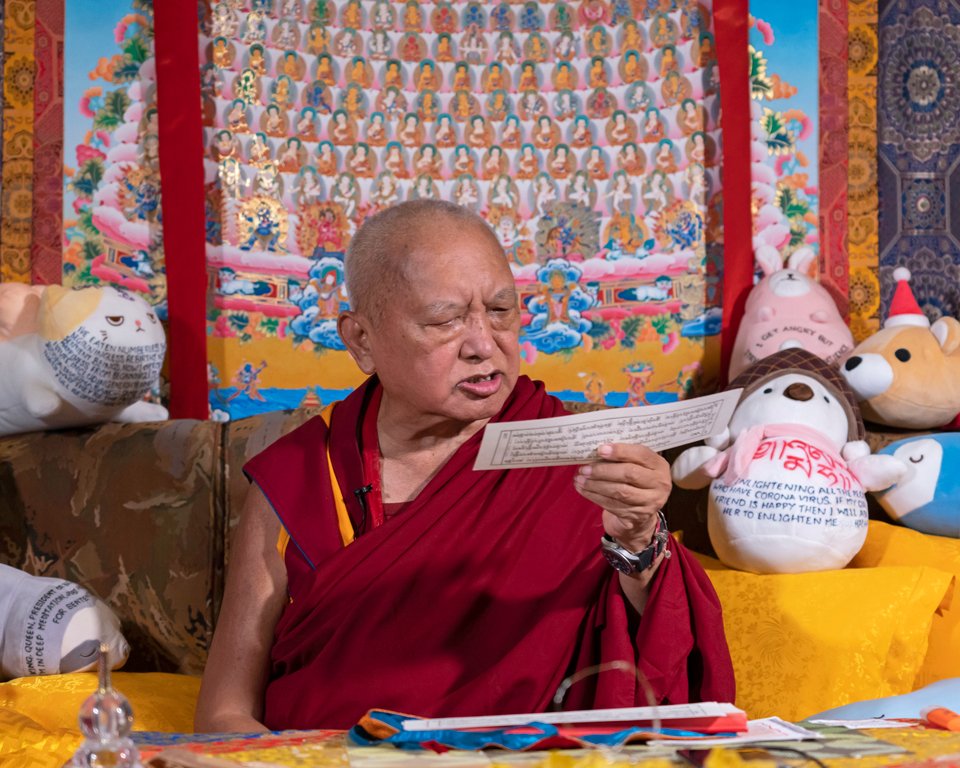
Lama Zopa Rinpoche offering an oral transmission, Kopan Monastery, Nepal, March 2021. Photo by Ven. Lobsang Sherab.
Lama Zopa Rinpoche continues his video teachings on thought transformation from Kopan Monastery in Nepal. Here is a summary of the most recent teaching:
Rinpoche begins this teaching continuing his oral transmission, or lung, of the Sutra of Great Liberation. Before offering the lung, Rinpoche reminds us to have a good motivation: our lives should be beneficial to sentient beings. Therefore, we should stop harming others. And not only that, we should also be working to free others from oceans of samsaric suffering and bring them to full enlightenment by oneself alone. Therefore, we must achieve the state of omniscience. For that reason, we are listening to the teaching on the Sutra of Great Liberation. Just by hearing the lung, we won’t get reborn in the lower realms at all! Even just hearing the name of this sutra, we won’t get reborn in the lower realms! Rinpoche continues the oral transmission at 07:49 in this video.
Rinpoche then discusses some things he is doing that benefit others.
For example, Rinpoche visited a Tibetan home for the elderly in Kathmandu and gave them advice as well as a thangka of the Bodhisattva Kshitigarbha. Rinpoche is also compiling a text for the Kopan monks and nuns to make their lives wise in Dharma practice. This text will include different mantras and instructions according to Rinpoche’s own style and will later be translated into English. Rinpoche is compiling another text for Tibetan lay people with a motivation and various quotations. This text will be a manual for one’s whole life, including getting up, getting dressed, washing, eating, walking, sitting, sleeping, etc., all according to His Holiness the Dalai Lama’s wishes and advice.
Rinpoche gave the motivation and framed holy images to another home for the elderly in Nepal. He also wants to have Namgyalma mantras in every room so that even mosquitoes, ants, and insects get purified while they are in that room. Rinpoche will frame an image of Amoghapasha for the people in the home, which purifies the five heavy negative karmas without break and the negative karma of abandoning holy Dharma. Also, before one dies, if they see Chenrezig (Avalokiteshvara), then this rebirth is the last rebirth for them. If you don’t want suffering, if you don’t like cancer, if you don’t like diabetes, if you don’t like the virus, diarrhea, headaches, if you don’t like any suffering, Rinpoche says, this is what you need to do to be free from samsara.
Rinpoche then makes the point that Buddhists shouldn’t just give the charity of food and shelter to the elderly. We have to offer Dharma to them as well. If you don’t do these things to help the elderly practice Dharma, it is no different than giving an animal food and shelter. You are giving material support, but for the mind—nothing.
We invite you to go deeper into the topics presented here, plus many others, by watching Rinpoche’s video and reading the full transcript of Rinpoche’s teaching.
Watch Lama Zopa Rinpoche’s teaching “Some Ways in Which Rinpoche Is Benefitting People”:
https://youtu.be/eyDan9p4wqM
- Read the transcript of Rinpoche’s teaching
- Find videos with Rinpoche giving the oral transmission of the Sutra of Great Liberatation
- Find Rinpoche’s Teachings on Thought Transformation translated into Spanish, Italian, French, Chinese, and Russian
- Dedication verses for COVID-19 Crisis Teachings
Watch more from the video series Lama Zopa Rinpoche’s Teachings on Thought Transformation during the Time of COVID-19 and find links to videos in transcripts, MP3s, additional practice advice, and more:
https://fpmt.org/fpmt/announcements/resources-for-coronavirus-pandemic/advice-from-lama-zopa-rinpoche-for-coronavirus/
Practice advice from our teachers, Dharma study-from-home opportunities, and more can be found on the page “Resources for the Coronavirus Pandemic.”
Lama Zopa Rinpoche is the spiritual director of the Foundation for the Preservation of Mahayana Tradition (FPMT), a Tibetan Buddhist organization dedicated to the transmission of the Mahayana Buddhist tradition and values worldwide through teaching, meditation and community service.
- Tagged: advice from lama zopa rinpoche, coronavirus, lama zopa rinpoche thought transformation video teaching, oral transmission, supporting elderly, sutra of great liberation, video
5
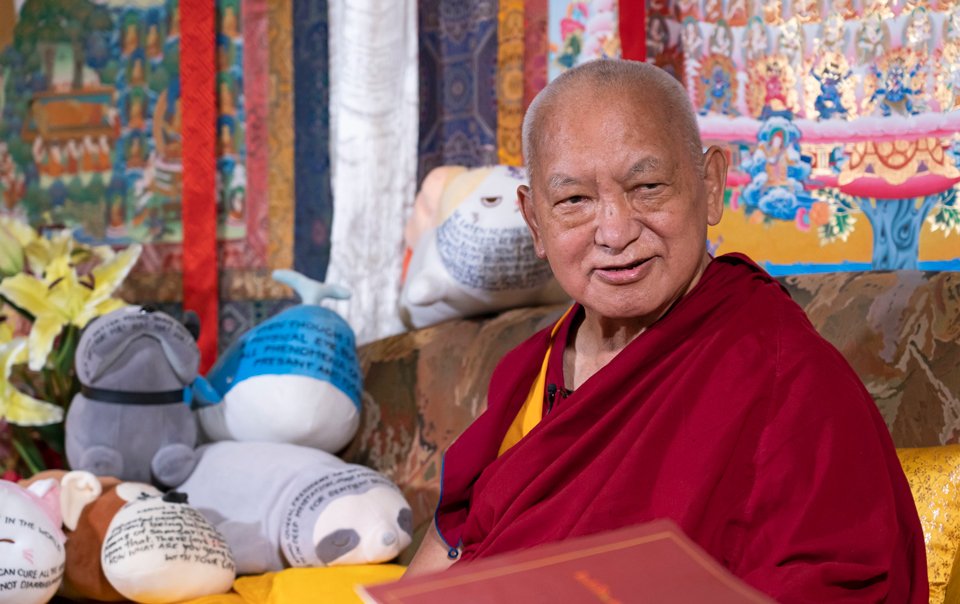
Lama Zopa Rinpoche giving an online teaching, Kopan Monastery, Nepal, March 2021. Photo by Ven. Lobsang Sherab.
Lama Zopa Rinpoche continues his video teachings on thought transformation from Kopan Monastery in Nepal. Here is a summary of the most recent teaching:
Rinpoche begins this teaching suggesting that if we can’t bear our present suffering, we should put a stop to anger, which is the cause of hell. Even the biggest suffering of a human being is great peace compared to a small suffering in hell. The suffering of hell is experienced until one’s non-virtue is finished—we should have the awareness that this is the result of anger.
Rinpoche recommends that we print out this verse (from chapter 6, verse 73) from Shantideva’s Bodhicharyavatara and hang it on our door so we remember:
If I can’t bear even
This much present suffering,
Why don’t I put a stop to anger,
The cause of hell suffering?
Rinpoche then engages in a lively and amusing debate with students in the room about where anger and attachment come from: the brain or the heart. This debate turns into a discussion about lo rig (mind and awareness).
Rinpoche then asks Ven. Fran Mohoupt how long she has been offering service to Kopan. Ani Fran tells Rinpoche it has been twenty-eight years. Rinpoche explains that her helping Kopan in this way is helping Rinpoche as well as serving His Holiness the Dalai Lama and Lama Lhundrup, and benefiting the six-realm sentient beings including tiny insects that the ordinary human eye cannot even see. Rinpoche advises Ani Fran that she shouldn’t think of her work for Kopan as a small thing. Whatever work any of us do at a Dharma center is benefiting the six-realm sentient beings.
We should take refuge and generate bodhichitta before starting any activity at a Dharma center. Any action we do with bodhichitta collects more merit than the sky! Rinpoche then advises that teachers should always begin a session by leading students in generating bodhichitta.
By making even one offering to the Buddha, you won’t get reborn in the lower realms for eons. Making offerings to a holy object is the same amount of merit as making offerings to Buddha—all holy objects are manifestations of buddhas. Because of this, whenever you see a holy object put your hands in the prostration mudra (thumbs tucked inside the palms), then turn your body toward the holy object. This only takes a few seconds and creates as many causes for enlightenment as there are holy objects. Putting your palms together and generating bodhichitta collects much more merit than offering universes filled with jewels to the buddhas. Offering even one water bowl with bodhichitta becomes a cause to free numberless sentient beings from oceans of samsaric suffering. The benefit of everything you do with bodhichitta goes to every single sentient being.
We have to recognize how fortunate we are to be born as human beings. Human life is so precious! Without recognizing this, we make ourselves into a sloth, anteater, or other unfortunate beings. This is the karma of ignorance. It’s not enough to recite mantras, we need to read the lamrim as well. Even if you don’t understand it, reading it leaves so many positive imprints and you can write down questions you have to ask other students or teachers later.
Rinpoche continues with the oral transmission of Sutra of Great Liberation at 1:14:08 of this video.
We invite you to go deeper into the topics presented here, plus many others, by watching Rinpoche’s video and reading the full transcript of Rinpoche’s teaching.
Watch Lama Zopa Rinpoche’s teaching “Everything You Do with Bodhichitta Benefits the Six Realm Sentient Beings“:
https://youtu.be/O4veZJCsW8k
- Read the transcript of Rinpoche’s teaching
- Find videos with Rinpoche giving the oral transmission of the Sutra of Great Liberatation
- Find Rinpoche’s Teachings on Thought Transformation translated into Spanish, Italian, French, Chinese, and Russian
- Dedication verses for COVID-19 Crisis Teachings
Watch more from the video series Lama Zopa Rinpoche’s Teachings on Thought Transformation during the Time of COVID-19 and find links to videos in transcripts, MP3s, additional practice advice, and more:
https://fpmt.org/fpmt/announcements/resources-for-coronavirus-pandemic/advice-from-lama-zopa-rinpoche-for-coronavirus/
Practice advice from our teachers, Dharma study-from-home opportunities, and more can be found on the page “Resources for the Coronavirus Pandemic.”
Lama Zopa Rinpoche is the spiritual director of the Foundation for the Preservation of Mahayana Tradition (FPMT), a Tibetan Buddhist organization dedicated to the transmission of the Mahayana Buddhist tradition and values worldwide through teaching, meditation and community service.
- Tagged: advice from lama zopa rinpoche, anger, coronavirus, lama zopa rinpoche thought transformation video teaching, oral transmission, sutra of great liberation, video
1

Lama Zopa Rinpoche giving an online teaching, Kopan Monastery, Nepal, March 2021. Photo by Ven. Lobsang Sherab.
Lama Zopa Rinpoche continues offering the oral transmission of the Sutra of Great Liberation in the latest video teachings on thought transformation from Kopan Monastery in Nepal. Here is a summary of the most recent teaching:
Lama Zopa Rinpoche begins this teaching advising that if we are scared of death, the Sutra of Great Liberation is exactly what we need. Even just hearing the name of this sutra frees us from the lower realms. There are unbelievable benefits to hearing and reading this powerful sutra. There are so many things in the world to be frightened of. This sutra is exactly what people need to hear, particularly if you are scared of death and dying.
Offering commentary on chapter 1, verse 4 of Shantideva’s Bodhicharyavatara, Rinpoche explains that if we don’t accomplish benefit with this perfect human rebirth, we won’t receive this opportunity again. Hearing the oral transmission of the Sutra of Great Liberation not only purifies past negative karma, it causes you not to be reborn in the lower realms again.
Taking the oral transmission of this incredible sutra to benefit ourselves is not enough. The real reason we take it is because we are responsible for numberless sentient beings, and the purpose of life is to benefit other sentient beings, even if it’s just one sentient being. We are not only responsible for our friends, or those who please us, but also our enemies. Further, there are numberless universes with numberless sentient beings, and numberless beings are suffering unbelievably in each of the hells. Human beings are suffering with so much ignorance, suffering, and hallucination. Not only that, there are numberless hungry ghosts, numberless animals in the numberless universes, and numberless suras, asuras, and intermediate state beings—we are responsible for them too! Therefore, we take the oral transmission of Sutra of Great Liberation because we need to achieve enlightenment to benefit others. You are listening for everyone! You have to think like that. It is not just for your happiness. Rinpoche explains that he received this oral transmission himself from Kirti Tsenshab Rinpoche.
Rinpoche continues the oral transmission (of the Sutra of Great Liberation where he previously left off, page 111. You can join in the continuation of the oral transmission (20:22 in this video).
While offering the oral transmission, Rinpoche stops to explain that this lineage came from Buddha. There are actually numberless buddhas, but you think, “I am alone! Nobody loves me!” In fact, there are numberless buddhas and bodhisattvas that love you and cherish you. Even the tiniest insect, every single ant—numberless buddhas and bodhisattvas cherish them the most. Therefore, how can you harm them? How dare you hurt them? When you don’t crush them or kill them, this is a small help to them, and also a great offering to the numberless buddhas and bodhisattvas.
Rinpoche also advises that we think that Shakyamuni Buddha or the numberless buddhas are giving you this oral transmission. Because the numberless buddhas became enlightened to benefit you, they are giving you the oral transmission.
Even reciting the mantra from Sutra of Great Liberation has unbelievable benefits. From the time you recite it up until enlightenment, you never get reborn in the lower realms. Unbelievable. Not only that, there are other most unbelievable benefits.
Mantra from Sutra of Great Liberation
NAMO BUDDHĀYA / NAMO DHARMĀYA / NAMAḤ SAṄGHĀYA / ADANTI DHĀRAṆĪ /
TADYATHĀ / AKAŚHANI VĀVĪNI / SARVA DHARMĀ NI VANĪ / IŚHAMANA / VIPAŚHANA/
VIMALA SUPARI / DHARMA NI KHANA / VARUNI CHAYA TAMALE / CHALE / HULU HULU /
ŚHIVITE / MANTRA MANTRA MANTRAḤ SVĀHĀ
We invite you to go deeper into the topics presented here, plus many others, by watching Rinpoche’s video and reading the full transcript of Rinpoche’s teaching.
Watch Lama Zopa Rinpoche’s teaching “The Numberless Buddhas Are Giving You the Oral Transmission“:
https://youtu.be/Z3wzyzJNkVI
- Read the transcript of Rinpoche’s teaching
- Find videos with Rinpoche giving the oral transmission of the Sutra of Great Liberatation
- Find Rinpoche’s Teachings on Thought Transformation translated into Spanish, Italian, French, Chinese, and Russian
- Dedication verses for COVID-19 Crisis Teachings
Watch more from the video series Lama Zopa Rinpoche’s Teachings on Thought Transformation during the Time of COVID-19 and find links to videos in transcripts, MP3s, additional practice advice, and more:
https://fpmt.org/fpmt/announcements/resources-for-coronavirus-pandemic/advice-from-lama-zopa-rinpoche-for-coronavirus/
Practice advice from our teachers, Dharma study-from-home opportunities, and more can be found on the page “Resources for the Coronavirus Pandemic.”
Lama Zopa Rinpoche is the spiritual director of the Foundation for the Preservation of Mahayana Tradition (FPMT), a Tibetan Buddhist organization dedicated to the transmission of the Mahayana Buddhist tradition and values worldwide through teaching, meditation and community service.
- Tagged: advice from lama zopa rinpoche, coronavirus, lama zopa rinpoche thought transformation video teaching, mantra from the sutra of great liberation, sutra of great liberation, video
30
Make Prayers by Means of the Six Remembrances
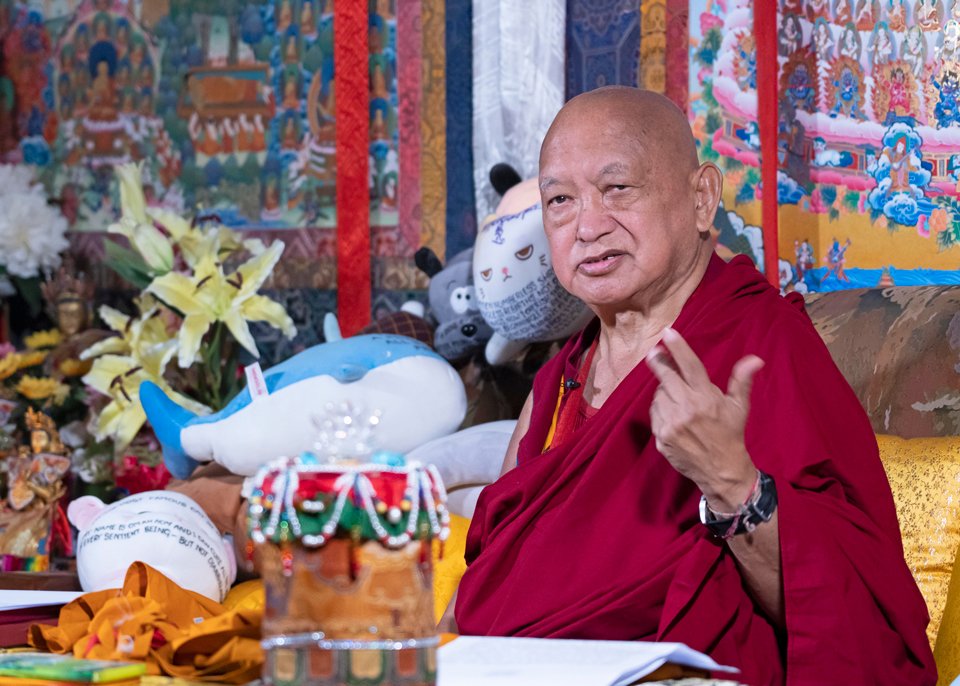
Lama Zopa Rinpoche giving an online teaching, Kopan Monastery, Nepal, March 2021. Photo by Ven. Lobsang Sherab.
Lama Zopa Rinpoche continues his video teachings on thought transformation from Kopan Monastery in Nepal. In this teaching, Rinpoche continues his commentary on the text The Hundred Clear Realizations of the Glorious One from Narthang, which describes how to make offerings and prayers on the anniversary of the passing of the guru. According to the text, in addition to the six remembrances you have as you make offerings, there are prayers you should make. Here is a summary of the most recent teaching:
Lama Zopa Rinpoche begins this teaching reminding us of our motivation for listening to the teachings, which is to free numberless sentient beings from oceans of samsaric sufferings and bring them to the total cessation of obscurations and the completion of realizations—full enlightenment—by oneself alone. Therefore, I must achieve enlightenment. Therefore, I’m going to listen to the teachings.
Rinpoche then continues his advice on what to do on the anniversary of your guru’s passing away by continuing to offer commentary on the text The Hundred Clear Realizations of the Glorious One from Narthang. On this occasion, it’s good to purify mistakes made in relation to the guru. Students should pray that all of the vices created in dependence on the guru are purified.
From the text:
Also for us, the vices that depend on the guru, such as harming the holy body, charging [the guru] money, disobeying the advice, expressing [the guru’s] vices, judging [the guru’s] holy mind, disturbing the holy mind, and so forth; may all this collection of vices, whatever occurred, be purified.
One mistake Rinpoche mentions is when a student gossips about and criticizes the guru’s perceived mistakes to others. By doing so, you are judging the guru’s mind with pride or anger, as if you can understand the level of the guru’s mind. Students should also avoid causing trouble for the holy mind of the guru.
On the anniversary of the guru’s passing away, one example of what to do is to pray to meet a perfect virtuous friend in all lifetimes and only please them. If you don’t correctly follow the guru, it is easy to create so much negative karma and the more gurus, the more potential negative karma. So it’s very good to pray to never displease the guru, not even for a second.
Another example from Rinpoche’s commentary on the verses of The Hundred Clear Realizations of the Glorious One from Narthang is to pray to enjoy the liberation story of the virtuous friend. By hearing the story of the guru—their unbelievable dedication and sacrifice—you realize this life has no essence, the guru gave up all the pleasures because samsaric pleasure is only suffering. By hearing their story you are inspired by their renunciation.
For example, the stories of the Sixteen Arhats inspire others to practice, particularly the Sangha. The sixteen arhats are enlightened beings doing the activities of a bodhisattva.
Rinpoche advises that on the anniversary of your guru’s passing it is also good to do the long version of Four Mandala Offerings of Tara Puja. Rinpoche then mentions that this needs to be translated into English.
Rinpoche indicated at the end of the video that he will soon be returning to teaching on the topic of emptiness.
We invite you to go deeper into the topics presented here, plus many others, by watching Rinpoche’s video and reading the full transcript of Rinpoche’s teaching.
Watch Lama Zopa Rinpoche’s teaching “Make Prayers by Means of the Six Remembrances”:
https://youtu.be/8HD90tBlNrA
- Read the transcript of Rinpoche’s teaching
- The Wish-fulfilling Gem Enhancing the Buddha’s Doctrine, a Method for Making Offerings and Prayers to Guru Shakyamuni Buddha and the Sixteen Arhats by Yeshe Gyaltsen
- Find Rinpoche’s Teachings on Thought Transformation translated into Spanish, Italian, French, Chinese, and Russian
- Dedication verses for COVID-19 Crisis Teachings
Watch more from the video series Lama Zopa Rinpoche’s Teachings on Thought Transformation during the Time of COVID-19 and find links to videos in transcripts, MP3s, additional practice advice, and more:
https://fpmt.org/fpmt/announcements/resources-for-coronavirus-pandemic/advice-from-lama-zopa-rinpoche-for-coronavirus/
Practice advice from our teachers, Dharma study-from-home opportunities, and more can be found on the page “Resources for the Coronavirus Pandemic.”
Lama Zopa Rinpoche is the spiritual director of the Foundation for the Preservation of Mahayana Tradition (FPMT), a Tibetan Buddhist organization dedicated to the transmission of the Mahayana Buddhist tradition and values worldwide through teaching, meditation and community service.
- Tagged: advice from lama zopa rinpoche, coronavirus, guru devotion, lama zopa rinpoche thought transformation video teaching, the hundred clear realizations of the glorious one from narthang, video
26
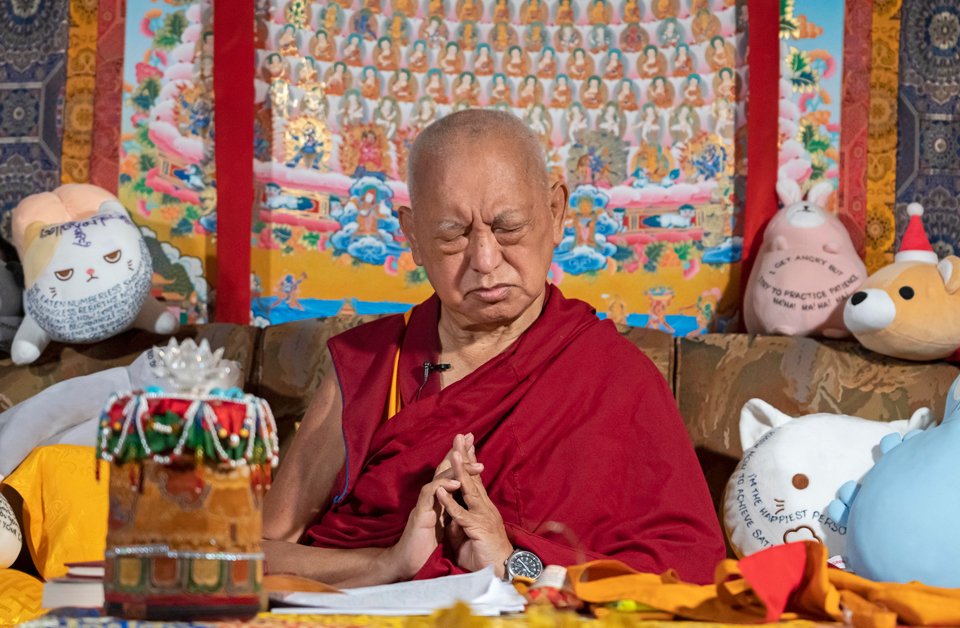
Lama Zopa Rinpoche during a video teaching, Kopan Monastery, Nepal, March 2021. Photo by Ven. Lobsang Sherab.
Lama Zopa Rinpoche continues his video teachings on thought transformation from Kopan Monastery in Nepal. Here is a summary of the most recent teaching:
Lama Zopa Rinpoche begins this teaching discussing the passing of a nun’s father, who died from a heart attack, a month after her mother had died of cancer and COVID-19. Rinpoche reminds us that when we hear about someone passing away it is always good to remember, “I will be the same thing, just a name. All that will be left of me is my name. That’s it, nothing else.” Anytime this can happen, Rinpoche says, and it’s very important to remember.
Even Buddhists don’t practice mindfulness of death, Rinpoche explains. You can discuss emptiness and study philosophy, but the basic first Dharma practice is renouncing attachment to this life and remembering death and impermanence. Even elderly people are shocked that they are going to die. When people you know die, it is an incredibly powerful teaching, reminding you that you can die at any time. If you don’t prepare now, it will be difficult for your mind to be happy when your breath stops.
From Verses of Advice for Meditating on Impermanence by Gungthang Tenpai Dronme:
If, while you have control over your life,
You don’t establish a firm basis for lasting happiness,
When the coming and going of your breathing stops,
It will be difficult for your mind to be happy.
Remembering death and impermanence brings you to Dharma. Even if you make offerings of lunch to hundreds of Maudgalypus and Sharipus, remembering death and impermanence for one second is better than that. Offering lunch won’t make you immediately lose the concept of permanence and remind you of Dharma. Buddha’s very last teaching was impermanence.
Rinpoche then reminds us of our motivation for listening to the teachings. We have total responsibility to free numberless sentient beings from oceans of samsaric sufferings and bring them to peerless happiness, the total cessation of gross and subtle obscurations and the completion of realizations. So you should think, “Therefore, I must achieve enlightenment to do that perfectly, without the slightest mistake. For that reason, I’m going to listen to the teachings.”
Rinpoche then explains that when our guru passes away we should follow the advice Rinpoche gave in his previous teaching, which is engaging in the six remembrances and doing pujas and practices, including Lama Chopa Tsog. This is incredible purification. If you have any negative karma collected with the guru, it is the greatest purification, and you collect the most extensive merits.
Rinpoche then continues his commentary on The Hundred Clear Realizations of the Glorious One from Narthang starting on page 7 of the teaching’s transcript. One point Rinpoche makes very strongly is that when we make offerings to the Sangha or lay people who are disciples of our own guru, we should think that we are making offerings to the guru’s own pores. First, generate bodhichitta, Ripoche says. Then whatever you are offering, to however many disciples of your guru, think, “I’m making offerings to each pore of my guru.” By doing this, you collect much more merit than if you had made offerings to numberless Buddhas, Dharma, and Sangha, and numberless statues, stupas, or scriptures. Even if you have a billion dollar business—that is nothing compared to doing this.
Rinpoche shares a story about how he offered money to monks in Tibet while thinking they were his root guru. Rinpoche shared that he visualized each monk as his guru while making the offerings.
Rinpoche then offers commentary on these verses from The Hundred Clear Realizations of the Glorious One from Narthang on how to offer and dedicate your roots of virtue to the guru (pages 11-15 of the transcript):
With strong devotion and respect for your guru, think that immeasurable buddhas and bodhisattvas are abiding as your witnesses.
All buddhas and bodhisattvas abiding in the ten directions, please think of me.
Sangha, please think of me.
By our making offerings to the Rare Sublime Ones; offering service to the Sangha, those intent on virtue; giving tormas to the bhutas; taking vows; doing recitations; accomplishing listening, reflecting, and meditating, and so forth; all these roots of virtue of however many merits of virtue and merits of transcendental wisdom have been collected—made into one and combined together, and then added together—we offer to our guru, the perfect virtuous friend, Gelong/Bodhisattva (insert his/her name), along with the lineage of the Father and Sons.
By making this offering, may the holy views of the gurus, the virtuous friends, be completed more and more. May all objects of abandonments of the graduated paths and bhumis, the obstacles, and the obscurations whatsoever be purified.
By proceeding gradually in the five paths and ten bhumis, may we and others achieve full enlightenment quickly for the sake of all sentient beings.
We invite you to go deeper into the topics presented here, plus many others, by watching Rinpoche’s video and reading the full transcript of Rinpoche’s teaching.
Watch Lama Zopa Rinpoche’s teaching “Make Offerings Thinking You Are Offering Them to Your Guru’s Pores“:
https://youtu.be/CCU8bVf7G9w
- Read the transcript of Rinpoche’s teaching
- Lama Chopa and Tsog Offering: A Method of Practice According to the Instructions of Lama Zopa Rinpoche
- Find Rinpoche’s Teachings on Thought Transformation translated into Spanish, Italian, French, Chinese, and Russian
- Dedication verses for COVID-19 Crisis Teachings
Watch more from the video series Lama Zopa Rinpoche’s Teachings on Thought Transformation during the Time of COVID-19 and find links to videos in transcripts, MP3s, additional practice advice, and more:
https://fpmt.org/fpmt/announcements/resources-for-coronavirus-pandemic/advice-from-lama-zopa-rinpoche-for-coronavirus/
Practice advice from our teachers, Dharma study-from-home opportunities, and more can be found on the page “Resources for the Coronavirus Pandemic.”
Lama Zopa Rinpoche is the spiritual director of the Foundation for the Preservation of Mahayana Tradition (FPMT), a Tibetan Buddhist organization dedicated to the transmission of the Mahayana Buddhist tradition and values worldwide through teaching, meditation and community service.
- Tagged: advice from lama zopa rinpoche, coronavirus, guru devotion, lama zopa rinpoche thought transformation video teaching, the hundred clear realizations of the glorious one from narthang, video
23
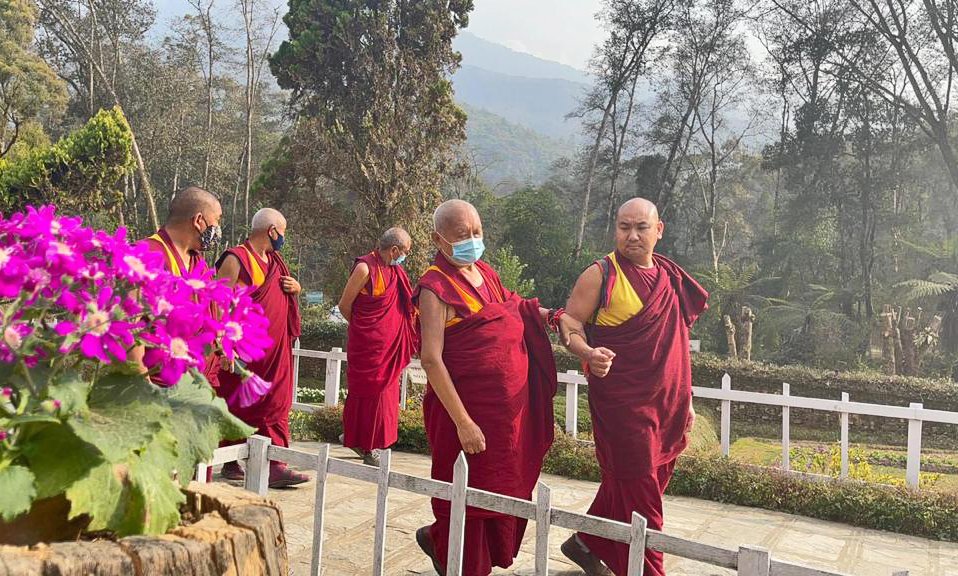
Lama Zopa Rinpoche walking in a Heruka holy place, where he had invited young monks for a picnic and offered tsog, Nepal, February 2021. Photo by Geshe Thubten Jangchub.
In the following short excerpt from Lama Zopa Rinpoche’s video teachings on thought transformation, Rinpoche explains that we live our whole life with the hallucination that the I exists from its own side, that it is a real I. Basic Buddhism is about discovering the self, discovering that the way the I, or self, appears is a total hallucination. Buddhism is not just about chanting rituals, Rinpoche says, it is for learning about our life!
Watch the three and a half minute video “Basic Buddhism Is Discovering Your Self”:
https://youtu.be/KZjn6g-xKSQ
Here is the transcript of Rinpoche’s teaching in this short video:
Of course, basically, it is dagdzin marigpa, the ignorance grasping the I. That which exists in mere name, but then it appeared and you believed with a wrong view as a real I, truly existing, existing from its own side, a real I. You live the whole… You do everything, every single [action] of your body, speech, and mind, every activity, you lead the whole entire life with this wrong concept and with this wrong view, this hallucination. You live the life; you do every single thing with this hallucination, believing it is real, believing everything is real. Real! You do everything, believing it is real, [believing] the hallucination is real, with the concept that it is real. You do everything. Wow, wow, wow. Amazing.
That, that is the basic, the very basic Buddhism—discovering your self! Discovering your self! Aaaah. Aaa-ah. You see? What is false in your life, what is truth in your life—oh, that is discovering your self. From beginningless rebirths up to now, how you have been believing your self, how things appear to your mind, is toooooooootally opposite. This is a hallucination. Aaaah. You have to realize this. That is the most important thing. It is basic Buddhism! Aaaah. Aaaah.
Now you really understand what Buddhism is! Aaaah. What Buddhism offers to your life, to learning about your life! Aaaah. You see? You have to recognize that. It is not just chanting blah, blah, blah. No, it is not like that. Not at all. It shows the truth! Aaaah. It is not just chanting blah, blah, blah. Many religions do chanting, making sounds. It is not just that. It is not just that. Now the more you learn now, now you can see what Buddhism is. How it is most important in your life. Aaaah. Like that.
Watch more from the video series Lama Zopa Rinpoche’s Teachings on Thought Transformation during the Time of COVID-19 and find links to videos in transcripts, MP3s, additional practice advice, and more:
https://fpmt.org/fpmt/announcements/resources-for-coronavirus-pandemic/advice-from-lama-zopa-rinpoche-for-coronavirus/
Lama Zopa Rinpoche is the spiritual director of the Foundation for the Preservation of Mahayana Tradition (FPMT), a Tibetan Buddhist organization dedicated to the transmission of the Mahayana Buddhist tradition and values worldwide through teaching, meditation and community service.
- Tagged: advice from lama zopa rinpoche, emptiness, essential extract, essential extract thought transformation teachings, video
22
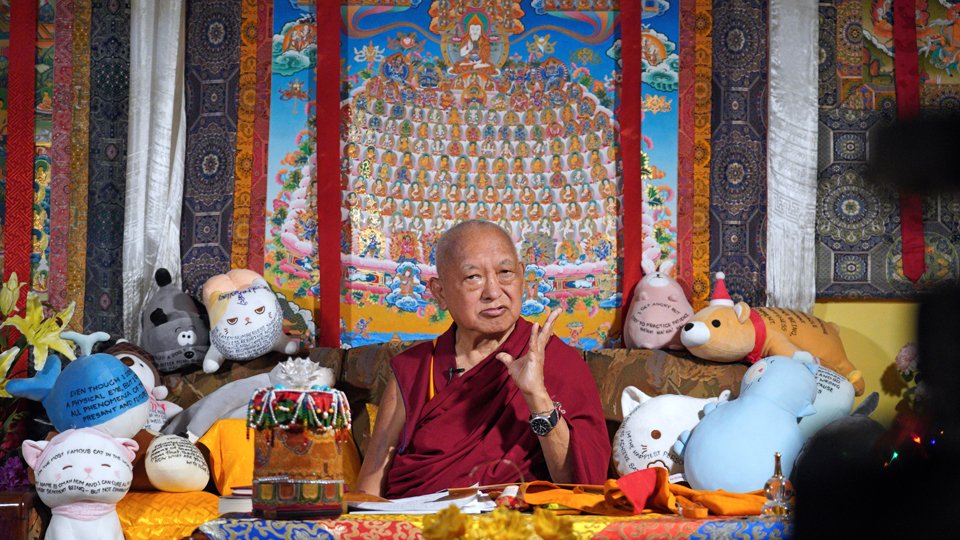
Lama Zopa Rinpoche doing his first video teaching for 2021, Kopan Monastery, Nepal, March 2021. Photo by Ven. Lobsang Sherab.
Lama Zopa Rinpoche continues his video teachings on thought transformation from Kopan Monastery in Nepal. Here is a summary of the most recent teaching:
Rinpoche begins this teaching extending his wishes that he hopes everyone had a nice long break from the teaching series (since December 16, 2020) and that we all are doing very well and using our time in a meaningful and beneficial way.
Rinpoche then extends those same wishes to every hell being, every hungry ghost, and every animal, including even the smallest insects and plankton. Rinpoche then reminds us that we have all been plankton numberless times in past lives. In fact, we have even been viruses numberless times! Rinpoche explains that since these tiny beings spread diseases such as COVID-19, we also have been those tiny beings numberless times, spreading diseases to others from beginningless rebirths. We have also been tigers and tiny biting insects numberless times, harming others, eating others, doing ugly actions, and creating fear.
It’s important to think about karma because it helps to recognize that life is not real, it’s more like a dream. If you think of the karma of being born as those beings in the lower realms, it is impossible to waste even a second of our precious human life distracted by attachment to pleasures of this life. Just like while you are dreaming, you believe everything is real when you are living your life. Only when you wake up, do you realize that everything is not as it appears. One day, when you are getting ready to die, you will realize that this life has been like a dream. Life happens, then is gone. We have to meditate on emptiness to recognize that life is a hallucination. Otherwise, we cheat ourselves every moment of every day by having a completely wrong concept. This is why it is so important to practice holy Dharma, so we don’t cheat ourselves. We have abused ourselves since beginningless rebirths.
Rinpoche then begins teaching us on what to do on the anniversary of our guru’s passing.
First, Rinpoche reminds us of the correct motivation for listening to the teachings, which is for happiness and not suffering. This is not for the temporary happiness of this life or even the happiness of liberation from samsara. The real purpose is to bring all the numberless sentient beings to Buddhahood—the total cessation of obscurations and completion of realizations. In order to do this, we must achieve omniscience. Without that, we can’t do perfect work for others without there being mistakes. We have to have perfect power to reveal the methods to gather sentient beings and complete compassion to embrace every sentient being in every realm. For this reason, we listen to the teachings, to achieve this.
Rinpoche then offers commentary on The Hundred Clear Realizations of the Glorious One from Narthang.
It is extremely meaningful to make offerings on the anniversary of your guru’s passing away, Rinpoche explains. You collect far greater merit by making offerings to the guru then you do by making offerings to all the three-time buddhas.
There are six benefits of making offerings on the anniversary of your guru’s passing away. The Hundred Clear Realizations of the Glorious One from Narthang offers the great Kadampa geshe Sharawa’s citation from Guhyasamaja and Vairochana’s Net of Magical Illusion:
- You complete your guru’s holy wishes.
- You purify the negative karmas and obscurations collected in dependence on the guru.
- You achieve extensive merits.
- In future lives, you meet gurus.
- You become an object to be subdued by gurus.
- You quickly cease your samsara.
Rinpoche offers commentary on each of these points and you can read this commentary in detail in the transcript of this teaching, starting at page 13.
When you make these offerings, you make them with the six remembrances:
- Remembering the aspect of the guru’s holy body when he was alive.
- Remembering that, first, after taking ordination, [your guru] was precise in the three higher trainings, and remember the qualities of the holy mind of [possessing] the transmitted teachings and direct realizations.
- Remembering the liberation stories of the divine teaching lineage of Great Jowo [Atisha], the Dharma tradition of great capable beings, which is not shared with other systems of the great charioteers.
- Remembering [the guru’s] kindness, thinking that all the perfections of samsara and beyond samsara, such as your own happiness, come from the guru.
- Remembering [the guru’s] blessing, thinking that everything you wish, such as being able to think of Dharma, is the blessing of the guru.
- Remembering to devote yourself [to the guru], imagining and bringing to mind that the guru and Buddha are not different.
Rinpoche offers commentary on each of these points, and we recommend following along in the transcript starting on page 17.
We invite you to go deeper into the topics presented here, plus many others, by watching Rinpoche’s video and reading the full transcript of Rinpoche’s teaching.
Watch Lama Zopa Rinpoche’s teaching “Make Offerings on the Anniversary of Your Guru’s Passing Away”:
https://youtu.be/Zh__457vmZs
-
- Read the transcript of Rinpoche’s teaching
- Find Rinpoche’s Teachings on Thought Transformation translated into Spanish, Italian, French, Chinese, and Russian
- Dedication verses for COVID-19 Crisis Teachings
Watch more from the video series Lama Zopa Rinpoche’s Teachings on Thought Transformation during the Time of COVID-19 and find links to videos in transcripts, MP3s, additional practice advice, and more:
https://fpmt.org/fpmt/announcements/resources-for-coronavirus-pandemic/advice-from-lama-zopa-rinpoche-for-coronavirus/
Practice advice from our teachers, Dharma study-from-home opportunities, and more can be found on the page “Resources for the Coronavirus Pandemic.”
Lama Zopa Rinpoche is the spiritual director of the Foundation for the Preservation of Mahayana Tradition (FPMT), a Tibetan Buddhist organization dedicated to the transmission of the Mahayana Buddhist tradition and values worldwide through teaching, meditation and community service.
- Tagged: advice from lama zopa rinpoche, coronavirus, guru devotion, lama zopa rinpoche thought transformation video teaching, the hundred clear realizations of the glorious one from narthang, video
16
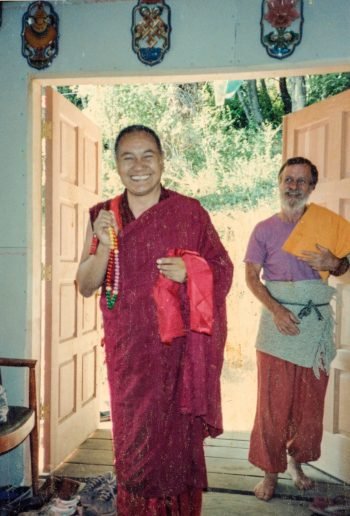
Lama Yeshe with Åge Delbanco, photo courtesy of Nicholas Ribush on Facebook
Lama Zopa Rinpoche requests for students who read obituaries belonging to members of our precious spiritual community, to please pray in the following manner: “May this person never ever be reborn in the lower realms and at the time of death be born in a pure land where they can be enlightened or to receive a perfect human body, meet the Mahayana teachings, and meet a perfectly qualified guru and by only pleasing the gurus mind, achieve enlightenment as quickly as possible.” Reading obituaries also helps us reflect upon our own death and rebirth and thus use our lives in the most meaningful way.
Åge Delbanco, who died on February 19, 2021, in California, US, was one of the earliest Western students of Lama Yeshe and Lama Zopa Rinpoche. Known by his nickname Babaji, he lived at Kopan in Nepal from 1970 to 1973. Even though Åge was from Denmark, California became his home. He became very involved at Vajarpani Institute a year after it started and lived there for thirteen years. He also served as an assistant to Lama Yeshe in 1983, when Lama Yeshe lived in the Santa Cruz-area for three months.
Åge died peacefully in his home in Santa Cruz at the age of 95, after a year of declining health. He had two close friends sitting with him as he passed, who provided him with Dharma support as he transitioned, reading prayers and practices from Lama Zopa Rinpoche’s book How to Face Death without Fear.
Lama Zopa Rinpoche sent a twenty-minute audio message after learning of Åge’s death. Here a short excerpt from Rinpoche’s message:
“So, please everybody pray for Babaji, who just passed away. Please everybody pray, especially the old students who knew him, thank you very, very much, and to not be reborn in lower realms. …
“Due to all the three time merits collected by oneself, three time merits collected by numberless sentient beings, numberless buddhas, may the Babaji be reborn in the pure land where he can be enlightened. Or, then he receives perfect human rebirth, meet Mahayana teachings, meet perfectly qualified Mahayana teacher, revealing the unmistaken path to enlightenment. And by pleasing most the holy mind of the Virtuous Friend, and then he achieve enlightenment as quick as possible.
“So please pray, at least like that. Thank you very much. Thank you very much. Babaji passing away is a teaching for us, teaching for us, reminding us of impermanence and death for ourself, and the need to make preparation for death, emphasizing to practice Dharma, without being lazy, and without the mind being distracted by attachment and anger.
“So yeah, to practice Dharma, to practice bodhichitta is the heart, and then, okay, thank you very much.”
Listen to the audio recording of Lama Zopa Rinpoche on the Death of Åge Delbanco:
An unedited transcript of the recording is available.
Rinpoche says this is the most critical time for a student, when we will all need the most help and support to avoid the lower realms and have a good rebirth. This is the time when students need to help each other. As soon as you hear of someone’s death, without hesitation, you can at least recite one mala of OM MANI PADME HUM. And then, according to one’s ability and availability, there are many other prayers and practices recommended for this purpose: https://fpmt.org/death/
Read a Mandala interview with Åge Delbanco from 2012.
Lama Zopa Rinpoche is the spiritual director of the Foundation for the Preservation of Mahayana Tradition (FPMT), a Tibetan Buddhist organization dedicated to the transmission of the Mahayana Buddhist tradition and values worldwide through teaching, meditation and community service.
12
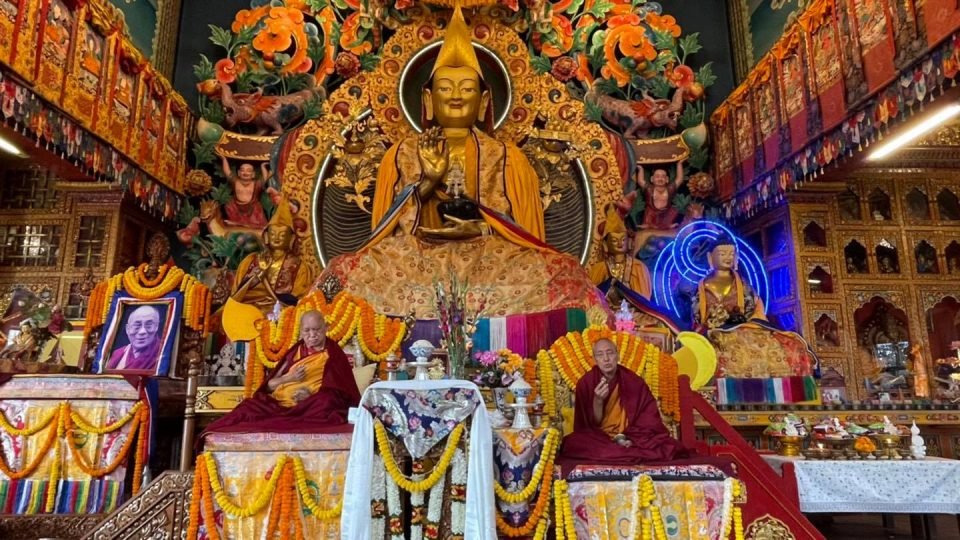
Lama Zopa Rinpoche and Khen Rinpoche Geshe Chonyi during the long life puja offered to both of them at Kopan Monastery, February 22, 2021.
Since mid-December, Lama Zopa Rinpoche has been taking a break from offering us his Thought Transformation during the Time of COVID-19 teaching series. Rinpoche is still in Nepal, at Kopan Monastery, and engaging in a variety of beneficial activities in the area. Below we share a few details of Rinpoche’s activities over the past couple of months.
A long life puja was offered to Lama Zopa Rinpoche and Khen Rinpoche Geshe Chonyi at Kopan Monastery on February 22, 2021. Rinpoche composed a long life prayer for Khen Rinpoche Geshe Chonyi, which was offered during the puja. One section of this prayer shared:
By revealing nakedly the excellent middle path free from extremes,
in which one realizes the reality of emptiness by realizing dependent-arising,
and realizes infallible cause and effect by realizing how things exist,
You are kind in freeing us from the ocean of suffering of beginningless cyclic existence.
O inconceivable virtuous spiritual friend,
May you live a long life and
May your wishes be spontaneously fulfilled!
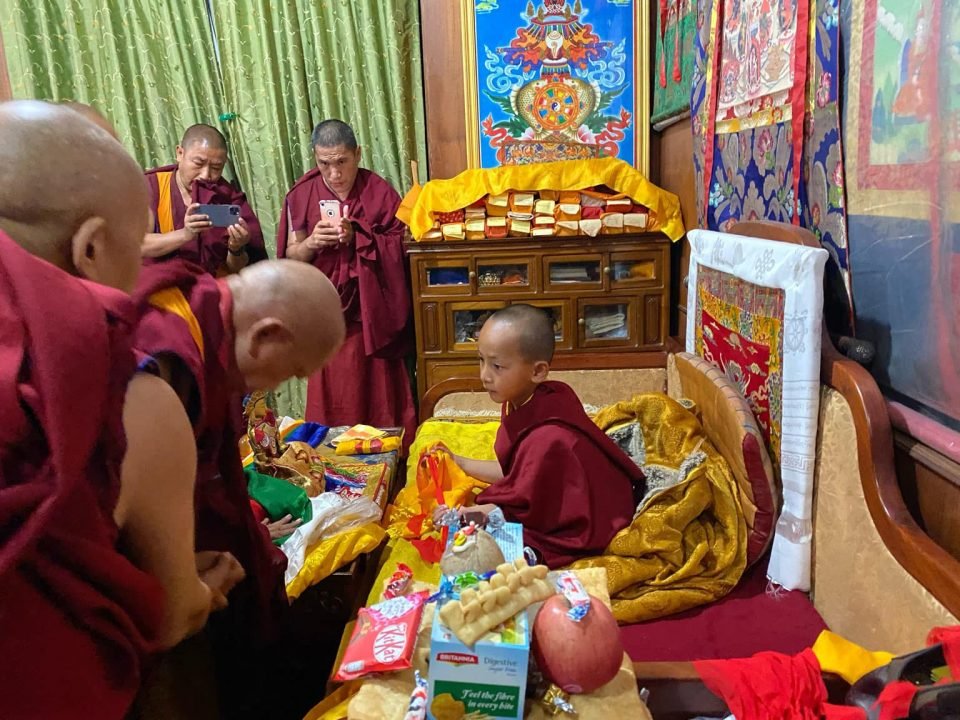
Lama Zopa Rinpoche meeting Trulshik Rinpoche, Nepal, February 20, 2021.
Rinpoche met the reincarnation of Trulshik Rinpoche on February 20 at his monastery in Swayambhunath. The previous Trulshik Rinpoche, who passed away in 2011, was one of Lama Zopa Rinpoche’s gurus.
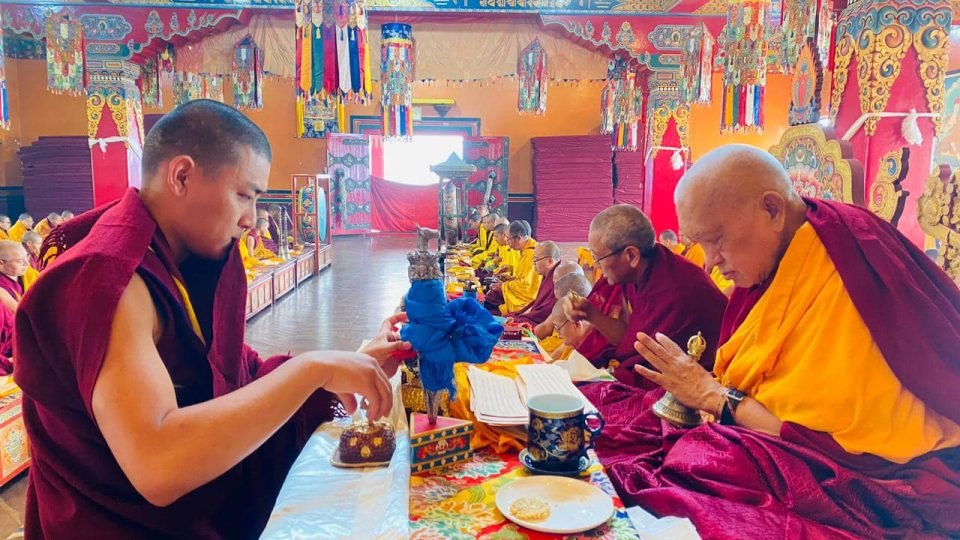
Lama Zopa Rinpoche, Khen Rinpoche Geshe Chonyi, and Kopan monks and nuns offering Most Secret Hayagriva Tsog Kong, February 13, 2021.
A Most Secret Hayagriva tsog kong puja to remove obstacles and benefit all beings was offered at Kopan Monastery on February 13 by Lama Zopa Rinpoche, Khen Rinpoche Geshe Chonyi, and Kopan monks and nuns. Several pujas of this type have offered for this purpose.
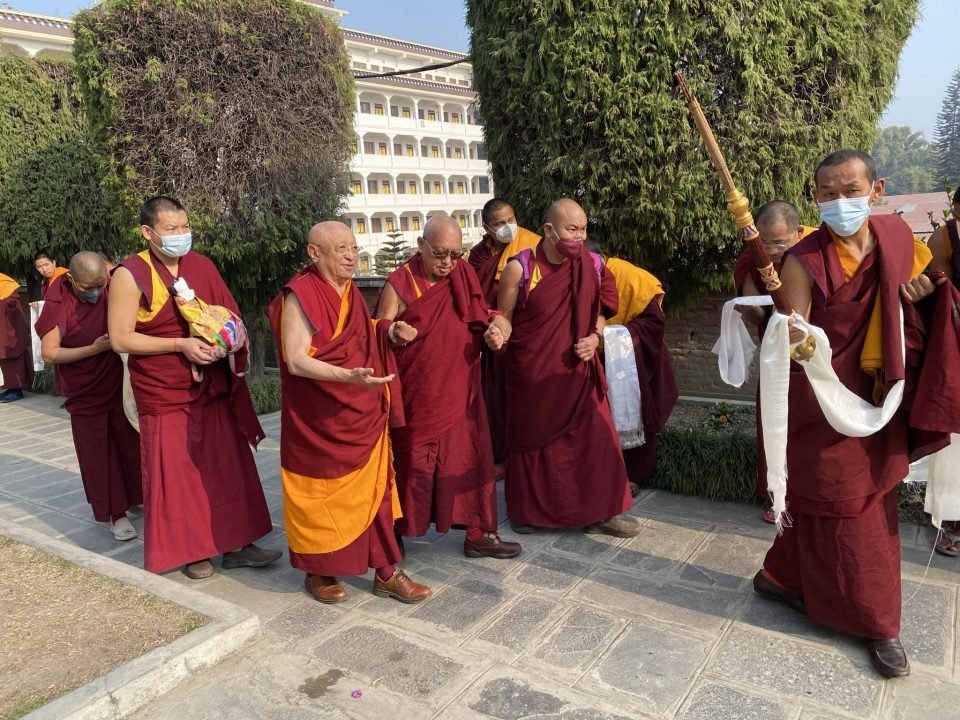
Lama Zopa Rinpoche walking with Chokyi Nyima Rinpoche, February 10, 2021. Photo by Lhundrup Topgye.
On February 10, Lama Zopa Rinpoche visited Ka-Nying Shedrup Ling Monastery in Kathmandu with Chokyi Nyima Rinpoche. Lama Zopa Rinpoche went to pay respects to the holy body of Chokling Rinpoche—who is Chokyi Nyima Rinpoche’s brother—and to offer an incense puja with Chokyi Nyima Rinpoche. There is beautiful and touching footage of this visit on Rinpoche’s Instagram.
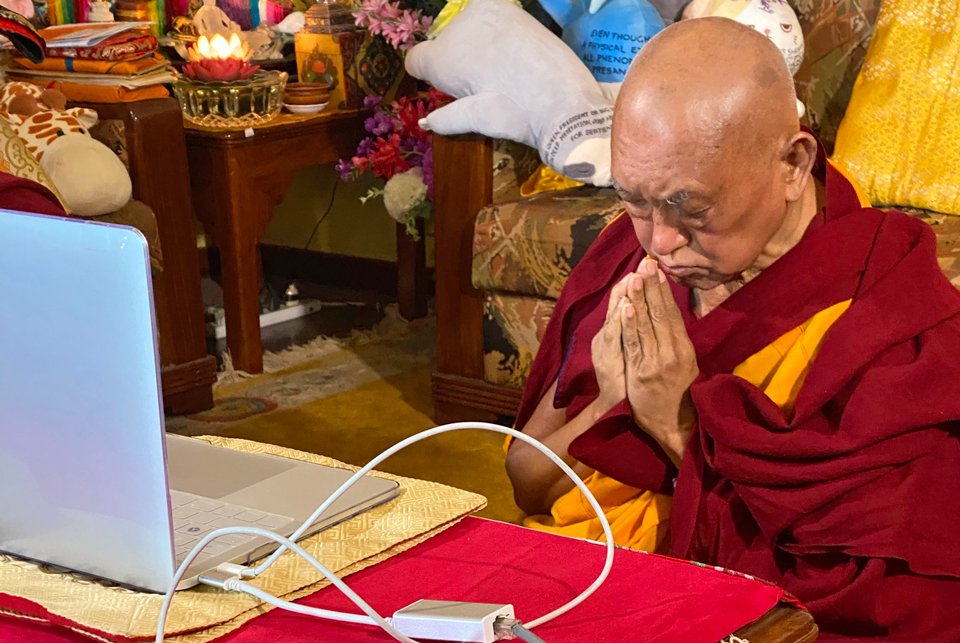
Lama Zopa Rinpoche during His Holiness the Dalai Lama’s teaching, Kopan Monastery, Nepal, February 8, 2021. Photo by Ven. Roger Kunsang.
His Holiness the Dalai Lama offered a teaching on Monday, February 8, 2021, at the request of Lama Zopa Rinpoche and the FPMT organization on Recognizing My Mother: An Experiential Song of the View (tagur ama ngodzin). The text, by the eighteenth-century Tibetan Buddhist master Changkya Rölpai Dorjé, is on dependent arising and emptiness. At the beginning and conclusion of the teaching, Lama Zopa Rinpoche read an introduction and dedication that he had composed for the teaching in Tibetan and made mandala offerings to His Holiness.
Rinpoche bought goats that were intended for slaughter and food on January 24 and blessed them before being released to their new home at the Animal Liberation Sanctuary. Rinpoche said, “Reciting prayers in their ears, verbally, to plant the seed of all the realizations of the path to enlightenment—this makes a huge difference. It has inconceivable result, unbelievable result.”
Please enjoy this video of Lama Zopa Rinpoche reciting mantras for these goats:
https://youtu.be/PNHl2LtBWx4
Rinpoche consecrated large appliqué Twenty-one Taras and Eight Taras That Save From Fear thangkas in the courtyard located outside the Kopan Monastery Gompa along with Khadro-la, Khen Rinpoche Geshe Chonyi, Kopan Lama Gyupas, and Kopan nuns on January 23. Rinpoche advised on every detail of these thangkas, and it took over a year for them to be made. They were offered to Rinpoche in a recent long life puja. After the consecration a special Tara puja was offered with Khadro la and the nuns.
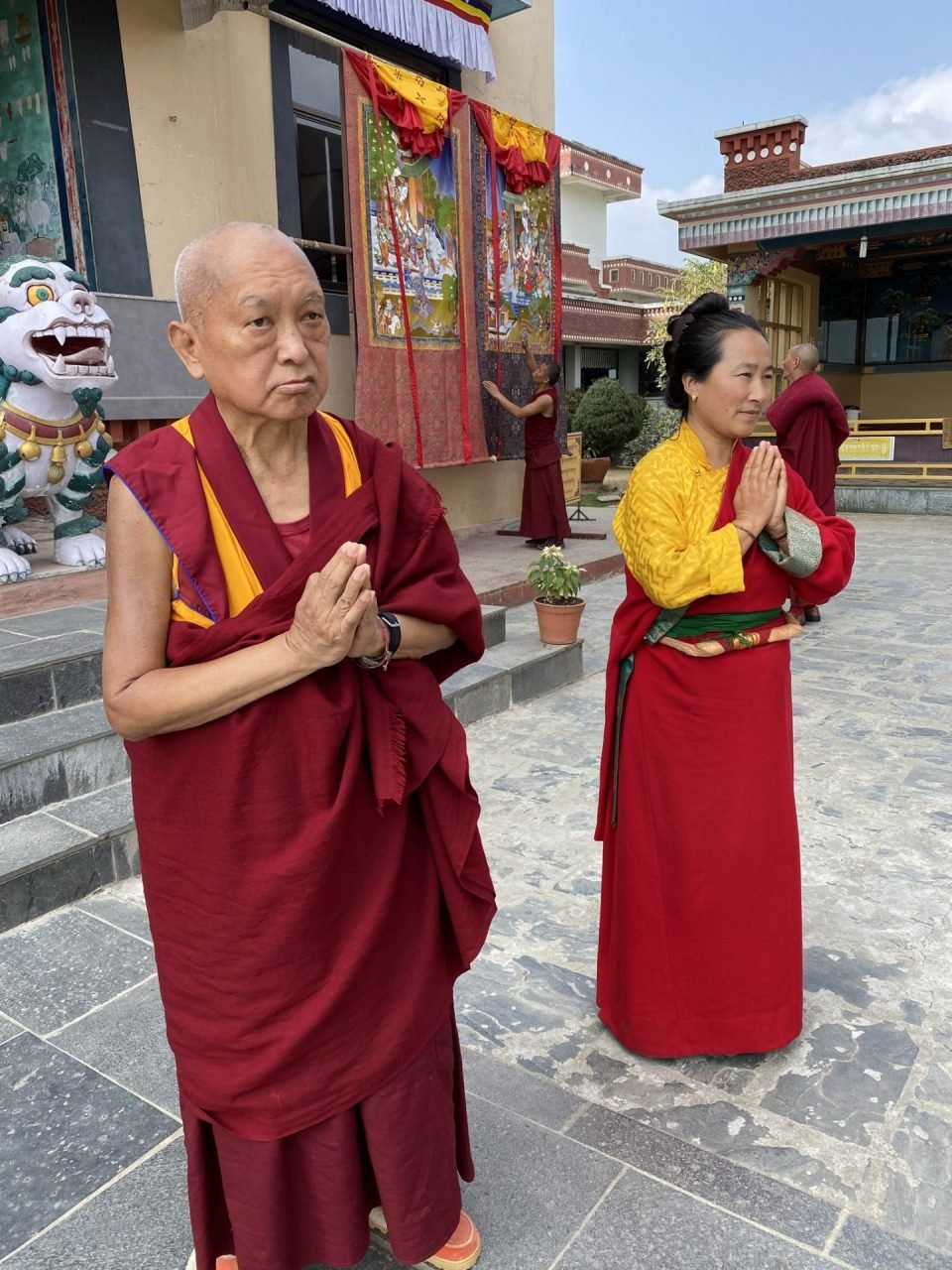
Lama Zopa Rinpoche and Khadro-la at the consecration of large appliqué Twenty-one Taras and Eight Taras That Save From Fear thangkas outside the Kopan Monastery Gompa. January 17, 2021, photo by Ven. Roger Kunsang.
Throughout this period Rinpoche has been giving lamrim teachings to the monks of Kopan Monastery and to the nuns of Kachoe Ghakyil Ling Nunnery.
These are just a few of the many auspicious activities Lama Zopa Rinpoche has been engaged in over the past couple of months at Kopan Monastery. We invite you to enjoy the new online galleries of photos, which show even more of Rinpoche’s recent activities, which we can all rejoice in:
- November and December 2020 photo gallery: fpmt.org/teachers/zopa/gallery/nepal-november-december-2020/
- January and February 2021 photo gallery: fpmt.org/teachers/zopa/gallery/nepal-january-february-2021/
Lama Zopa Rinpoche is the spiritual director of the Foundation for the Preservation of Mahayana Tradition (FPMT), a Tibetan Buddhist organization dedicated to the transmission of the Mahayana Buddhist tradition and values worldwide through teaching, meditation and community service.
Watch the video series Lama Zopa Rinpoche’s Teachings on Thought Transformation during the Time of COVID-19 and find links to videos in transcripts, MP3s, additional practice advice, and more:
https://fpmt.org/fpmt/announcements/resources-for-coronavirus-pandemic/advice-from-lama-zopa-rinpoche-for-coronavirus/
- Tagged: animal liberation, lama zopa rinpoche, lama zopa rinpoche activities, long life puja, trulshik rinpoche
10
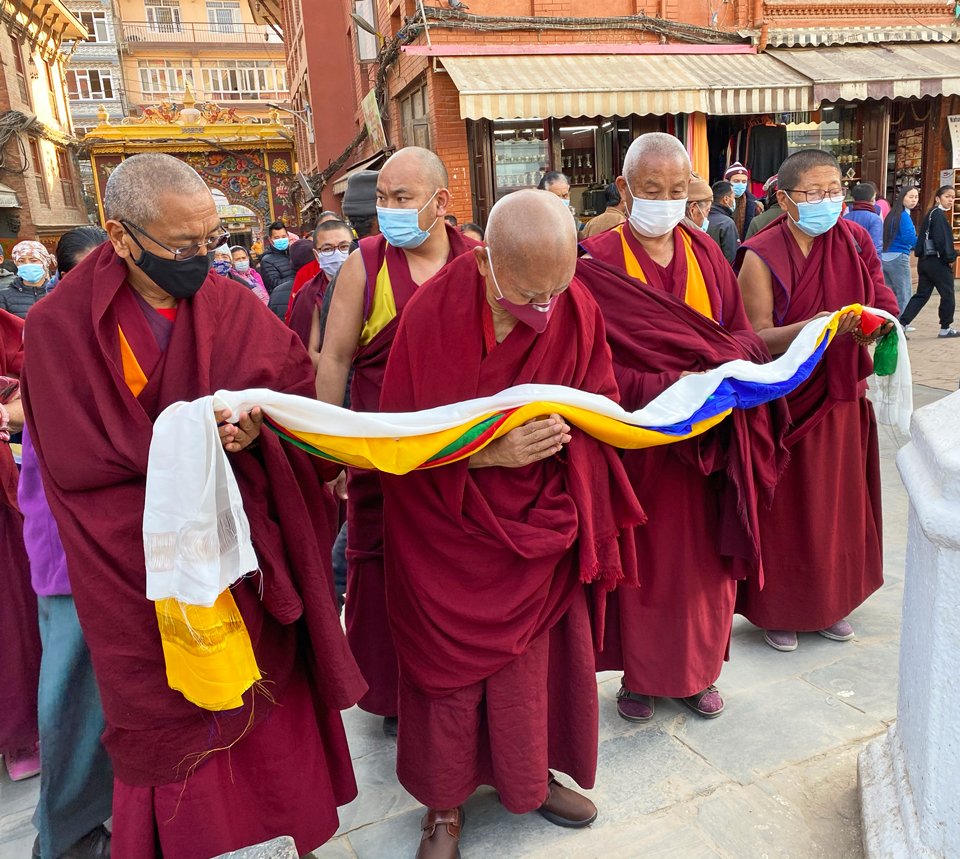
Khen Rinpoche Geshe Chonyi, Lama Zopa Rinpoche, Gen Tenpa Choden, and Ani Jangsem offering five-colored khata to the Boudha Stupa with prayers, Nepal, February 2021. Photo by Ven. Roger Kunsang.
In the following excerpt from Lama Zopa Rinpoche’s video teachings on thought transformation, Rinpoche explains that every single holy object is the basis for you to create all the merits that bring every success and pleasure that you experience now, as well causing your future liberation and enlightenment. All these holy objects came from every single sentient being, including the tiniest ant. Therefore, they are all sooooo precious, much more precious to us than millions of dollars. Whether a person is Buddhist or not, just seeing a holy object allows them to create soooo much merit.
If you put your hands together in prostration when you see a holy object, as well as offering lights and flowers rather than just thinking, “This is just a statue or painting,” you create even more merits than if you were to just see it.
Rinpoche explains that your motive for every daily activity should be only to benefit every living being and bring them to enlightenment. Getting up in the morning, dressing, eating breakfast, taking medicine, working, studying, meditating, and so forth, all should be done with the wish to benefit every single living being, including the tiniest insect.
Then you’ll have such a happy life, Rinpoche explains. You’ll have no regrets now, and when you die and in your future lives, you’ll achieve every success and realization, especially being able to benefit so many sentient beings. You should realize that you’re soooooo fortunate! This awareness will persuade you to create as much merit as possible.
Watch the eighteen minute video “Every Holy Object Comes from Every Sentient Being”:
https://youtu.be/sEqLVPQU7uA
Here is the transcript of Rinpoche’s teaching in this video:
Not Only Buddha, Dharma, and Sangha but Every Single Holy Object Comes from Every Sentient Being
Even the holy objects, not only Buddha, Dharma, and Sangha, but even every single holy object came from every insect, every human being. Not only every Buddha, Dharma, and Sangha came from them, but every statue, stupa, scripture—with which we create every single merit, the cause of happiness, the cause of enlightenment—came from them. We received [every single merit] from them, from every sentient being, every insect, every ant, every mosquito, every hell being, every hungry ghost, every animal, every human being, every sura being, every asura being, every sentient being. So they are the most precious.
Just by Seeing a Painting or Statue of a Buddha You Collect Numberless Greater Merits Than by Making Offerings to Solitary Realizer Arhats Equaling the Atoms of the Whole Entire Universe
[Sutra of the Mudra Developing the Power of Devotion says:འཇམ་དཔལ་རིགས་ཀྱི་བུའམ། རིགས་ཀྱི་བུ་མོ་གང་ལ་ལ་ཞིག་གིས་བསྐལ་པ་གངྒཱའི་ཀླུང་གི་བྱེ་མ་སྙེད་དུ་འཇིག་རྟེན་གྱི་ཁམས་ཐམས་ཅད་ཀྱི་རྡུལ་སྙེད་ཀྱི་རང་སངས་རྒྱས་དག་ལ་ཉིན་གཅིག་བཞིན་དུ་ལྷའི་ཟས་རོ་བརྒྱ་དང་ལྡན་པ་བྱིན་པ་དང་། དེ་བཞིན་དུ་ལྷའི་གོས་རྣམས་སྦྱིན་པ་བྱིན་པ་བས། འཇམ་དཔལ་རིགས་ཀྱི་བུའམ། རིགས་ཀྱི་བུ་མོ་གཞན་གང་ཞིག་གིས་སངས་རྒྱས་རི་མོར་བྲིས་པའམ། གཟུགས་སུ་བྱས་པ་མཐོང་ན། འདི་ནི་དེ་བས་བསོད་ནམས་ཆེས་གྲངས་མེད་པར་སྐྱེད་ན། ཐལ་མོ་སྦྱོར་བ་འམ། མེ་ཏོག་གམ། བདུག་པའམ། སྤོས་སམ། མར་མེ་འབུལ་བ་ལྟ་ཅི་སྨོས་ཏེ། འདི་ནི་དེ་བས་ཆེས་བསོད་ནམས་གྲངས་མེད་པར་སྐྱེད་ཏེ། ཞེས་གསུངས་སོ།
Jam päl rig kyi bu’am / rig kyi bu mo gang la la zhig gi käl pa gang gäi lung gi je ma nye du jig ten gyi kham tham chä kyi dül nye kyi rang sang gyä dag la nyin chig zhin du lhäi zä ro gya dang dän pa jin pa dang / de zhin du lhäi gö nam jin pa jin pa pä / jam päl rig kyi bu’am / rig kyi bu mo zhän gang zhig gi sang gyä ri mor dri pa’am / zug su jä pa thong na / di ni de wä so nam chhe drang me par kye na / thäl mo jor wa am / me tog gam / dug pa’am / pö sam / mar me bül wa ta chi mö te / di ni de wä chhe sö nam drang me par kye te / zhe sung so
Buddha said, “Manjushri, a boy or girl of the race, for eons equaling the sand grains of the River Ganga, offers divine food of a hundred tastes and, likewise, divine dress every day to solitary-realizer buddhas equaling the atoms of the whole entire universe, but, Manjushri, any other boy or girl of the race who sees a painting or statue of a buddha collects numberless greater merits. What need is there to mention that anyone who puts their palms together or offers flowers, scent, incense, or lights collects numberless greater merits than that?”]
So, there it says, if you see, just by seeing—it doesn’t matter whether you have devotion or non-devotion [or whether] you are a Buddhist or not—just by seeing a statue of Buddha or a painting of Buddha, just by that, just by seeing it, you create faaaaar more numberless, numberless greater merits, greater merits, but numberless, you create than the next one. You have to understand it well! [Than] for a hundred, for, I think, a hundred eons. I think that but I don’t [remember]. You get faint [when you understand for how many] eons. But for how many eons? According to the number of sand grains, the sand grains of the River Ganga, the Indian River Ganga. According to the number of… Eons, how many eons? According to the number of the sand grains of the River Ganga. I always forget that one.
By Putting Your Hands Together and Making Offerings to a Painting or Statue of a Buddha You Collect Numberless Greater Merits Than by Seeing It
Then it says, then it says, thäl mo jor wa am, “if you put the palms together like this or offer flowers or incense,” “scented smell or incense,” powder incense, stick incense, scented smell, incense stick, “or light….” Before I was telling [this to] the people who are offering water bowls here, so I was adding “water bowls.” It doesn’t mention water bowls but it is the same for everything. It can fit all the offerings. Before, I mentioned it before they left. I think before the last one left.[1] [If you offer] water bowls, no question, [you collect] even greater merit and numberless times than seeing a painting of Buddha, a picture, or a statue of Buddha. Di ni de wä chhe sö nam drang me par kye te / zhe sung so.
It is most incredible, most incredible, incredible. But many times we don’t know that, so, [we think] “Oh, that’s [just] a statute.” Even if you know it is a statue but you don’t do even this prostration, putting the palms together, you do nothing [due to thinking,] “Oh, that is [just] a statue or stupa.” You collect [so many merits] if you do like this. (Rinpoche shows putting the hands together in prostration.) So just by seeing you collect greater merits than before, all that, just by seeing a painting, picture, or statue. Oh, that is greater merits and numberless! Then, after that, if you do like this (Rinpoche shows putting the hands together in prostration) [you collect] even greater merits than before and numberless! For example, [if you prostrate to] Buddha.
All the Holy Objects Come from the Kindness of Every Single Insect, So They Are So Precious
So, all these holy objects that we see, we see numberless holy objects, statues, stupas, scriptures, they came from this mosquito, by the kindness of this mosquito, this ant, this tiny insect on humid wood. Whatever shape, [such] that it looks like a spider or whatever, [it came from] their kindness. It came from them. Wow, wow, wow. They are soooooo precious. Wow, wow, wow. They are sooooooooooooo precious, sooooooooooooo precious, sooooooooooooo precious. Now I ruin my voice. Now I ruin my voice. I have to save it.
It is incredible, if you know. So, their kindness, they are precious not by qualities as a buddha [is precious] but by their kindness. Aaaah. They are so, so, so precious. They are more precious than the Buddha, Dharma, and Sangha to whom we always pray, as I said before. We get liberated from the lower realms by remembering them (you don’t want to get reborn in the lower realms when you die) and you even get free from samsara and even get free from the lower nirvana, so you get enlightenment, free from suffering and obscurations. So, it all came from every sentient being, every insect. So, they are so precious. Lama khyen, lama khyen.
The Happiness That Comes from Money is Nothing Compared to the Happiness that Comes from Sentient Beings
Why do you think money is so precious, everybody spends the life, in the world people who don’t know, who doesn’t practice pure Dharma, they use their body, speech, and mind, even if human life is so precious, they use their whole life to make money, then they die. They suffer for money.
Now I’m forgetting what I’m saying.
So now I’m using the example of money. Because if we have money we can buy whatever we want, so everybody is working for money for that. But that is nothing. That is nothing. Happiness came from, as I said before, from sentient beings. All your happiness from beginningless rebirths, now, and in the future, temporary and ultimate, liberation and enlightenment, totally, everything came from sentient beings.
Whatever Happiness You Offer Even to a Tiny Insect Is So Important and So Precious
I was telling the monks, so therefore—I’m not going to talk much, just only about emptiness—so I told them that offering service to them, even to a tiny insect, whatever they need you offer, even giving food to the ants, not only to big [animals] but to tiny [ones], whatever you can do to serve them, whatever happiness you can offer to save them from suffering, whatever you can do is sooooooooooooo important, important, important, so precious, so precious. For you, it is so precious. It is most precious for you, so precious, precious, precious. It is so, so important for you, so precious, wow, wow, wow, whoa, anything you can do.
Doing Every Activity in the Service of Other Sentient Beings Is So Important
So, that’s why the motivation is to benefit sentient beings. Then, you get up, get dressed, and eat breakfast to benefit sentient beings, for them to achieve enlightenment, to free them from samsara and achieve enlightenment. To work for them, to benefit them, you are eating breakfast. Then you are going to work with that motivation to benefit sentient beings, to achieve enlightenment for sentient beings so that you can do perfect work. So, for the sentient beings, you are doing your work. Then having lunch. Then you are going, for sentient beings you are going to sleep. For sentient beings, everything is for sentient beings. Even if you are studying, any subject, Dharma or whatever, meditation, everything is for sentient beings. Eating medicine [is for sentient beings].
It is so important. So, it is very important, the service. It becomes service to all sentient beings, to the numberless sentient beings, to every tiny, tiniest insect, to the tiniest ones in the water, the ocean, I don’t remember the name. So, it is like that. You see? It is so important. Whatever you do by changing the motivation [and doing it] for others, then it becomes so, so important. It becomes very important service. It is so important [when you are] doing it for others, as service for others. Even studying Dharma, reflecting, meditation, even eating, sleeping. Then, your life is so happy. Most happy your life is. You have no regret. Now when you die, you are very happy, so satisfied, so happy. And in the future, you are so happy. From life to life, you have great success in benefiting sentient beings, [you have] more realizations, and [you are of] greater benefit to sentient beings. Then your happiness increases life to life and you go towards enlightenment. Wow, wow, wow.
That is okay. Now, the talk.
The Benefits You Get from the Numberless Buddha, Dharma, Sangha, Statues, Stupas, and Scriptures Come from Every Single Sentient Being
So, what I’m saying is that the numberless Buddha, Dharma, Sangha, statues, stupas, and scriptures, which, as I just mentioned, are of so much benefit to you, wow, wow, wow, you receive by every single sentient being, every single insect, the numberless hell beings, hungry ghosts, so sentient beings. Sentient beings are the most precious, most kind, most dear, wish-fulfilling, your wish-fulfilling. [From them come] aaaaaaaaaaaall temporary and ultimate happiness, liberation, enlightenment.
[1] Lama Zopa Rinpoche is referring to several students who helped Ven. Tenzin Namdrol with the water bowls during the lockdown at Kopan Monastery but then left to return to their home countries.
You can find resources and links on the topic of holy objects on the FPMT Education page Holy Objects.
Watch more from the video series Lama Zopa Rinpoche’s Teachings on Thought Transformation during the Time of COVID-19 and find links to videos in transcripts, MP3s, additional practice advice, and more:
https://fpmt.org/fpmt/announcements/resources-for-coronavirus-pandemic/advice-from-lama-zopa-rinpoche-for-coronavirus/
Lama Zopa Rinpoche is the spiritual director of the Foundation for the Preservation of Mahayana Tradition (FPMT), a Tibetan Buddhist organization dedicated to the transmission of the Mahayana Buddhist tradition and values worldwide through teaching, meditation and community service.
- Home
- News/Media
- Study & Practice
- About FPMT Education Services
- Latest News
- Programs
- New to Buddhism?
- Buddhist Mind Science: Activating Your Potential
- Heart Advice for Death and Dying
- Discovering Buddhism
- Living in the Path
- Exploring Buddhism
- FPMT Basic Program
- FPMT Masters Program
- FPMT In-Depth Meditation Training
- Maitripa College
- Lotsawa Rinchen Zangpo Translator Program
- Universal Education for Compassion & Wisdom
- Online Learning Center
- Prayers & Practice Materials
- Overview of Prayers & Practices
- Full Catalogue of Prayers & Practice Materials
- Explore Popular Topics
- Benefiting Animals
- Chenrezig Resources
- Death & Dying Resources
- Lama Chopa (Guru Puja)
- Lama Zopa Rinpoche: Compendium of Precious Instructions
- Lama Zopa Rinpoche: Life Practice Advice
- Lama Zopa Rinpoche Practice Series
- Lamrim Resources
- Mantras
- Prayer Book Updates
- Purification Practices
- Sutras
- Thought Transformation (Lojong)
- Audio Materials
- Dharma Dates – Tibetan Calendar
- Translation Services
- Publishing Services
- Teachings and Advice
- Find Teachings and Advice
- Lama Zopa Rinpoche Advice Page
- Lama Zopa Rinpoche: Compendium of Precious Instructions
- Lama Zopa Rinpoche Video Teachings
- ༧སྐྱབས་རྗེ་བཟོད་པ་རིན་པོ་ཆེ་མཆོག་ནས་སྩལ་བའི་བཀའ་སློབ་བརྙན་འཕྲིན།
- Podcasts
- Lama Yeshe Wisdom Archive
- Buddhism FAQ
- Dharma for Young People
- Resources on Holy Objects
- Ways to Offer Support
- Centers
- Teachers
- Projects
- Charitable Projects
- Make a Donation
- Applying for Grants
- News about Projects
- Other Projects within FPMT
- Support International Office
- Projects Photo Galleries
- Give Where Most Needed
- FPMT
- Shop
Translate*
*powered by Google TranslateTranslation of pages on fpmt.org is performed by Google Translate, a third party service which FPMT has no control over. The service provides automated computer translations that are only an approximation of the websites' original content. The translations should not be considered exact and only used as a rough guide.When a strong wind blows, the clouds vanish and blue sky appears. Similarly, when the powerful wisdom that understand the nature of the mind arises, the dark clouds of ego disappear.







